Search Result
Results for "
glioblastoma
" in MedChemExpress (MCE) Product Catalog:
7
Isotope-Labeled Compounds
| Cat. No. |
Product Name |
Target |
Research Areas |
Chemical Structure |
-
- HY-149584
-
|
|
Estrogen Receptor/ERR
|
Cancer
|
|
CIDD-0149897 is a potent, selective and brain-penetrant ERβ agonist. CIDD-0149897 exert antitumor functions in glioblastoma .
|
-
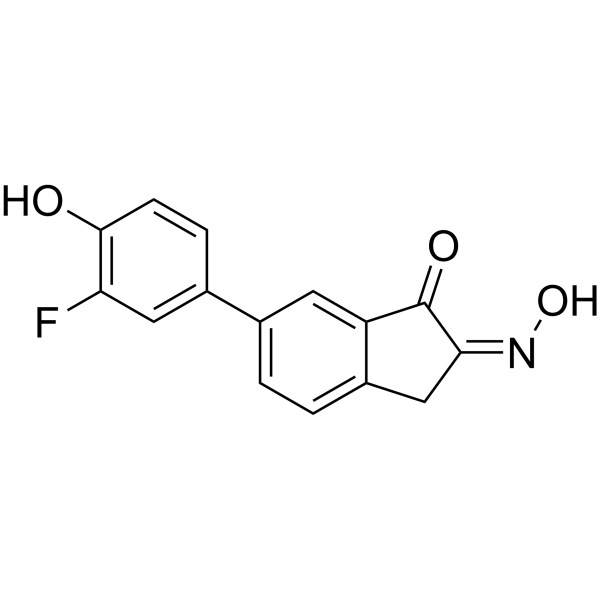
-
- HY-160054
-
|
|
Others
|
Cancer
|
|
GMT 3 aptamer sodium is a nucleic acid aptamer targeting different glioblastoma cell lines and exhibits high affinity .
|
-

-
- HY-160056
-
|
|
Others
|
Cancer
|
|
GMT 5 aptamer sodium is a nucleic acid aptamer targeting different glioblastoma cell lines and exhibits high affinity .
|
-

-
- HY-160058
-
|
|
Others
|
Cancer
|
|
GMT 9 aptamer sodium is a nucleic acid aptamer targeting different glioblastoma cell lines and exhibits high affinity .
|
-
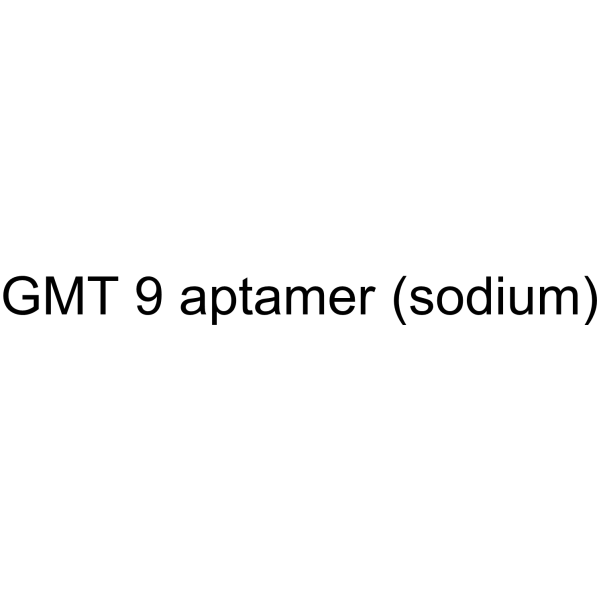
-
- HY-156266
-
|
Rhiz
|
Others
|
Cancer
|
|
Rhizochalinin (Rhiz) is a cytotoxic sphingolipid. Rhizochalinin (Rhiz) counteracts glioblastoma cell proliferation by inducing apoptosis, G2/M-phase cell cycle arrest, and inhibition of autophagy. Rhizochalinin (Rhiz) can be used for human glioblastoma research .
|
-
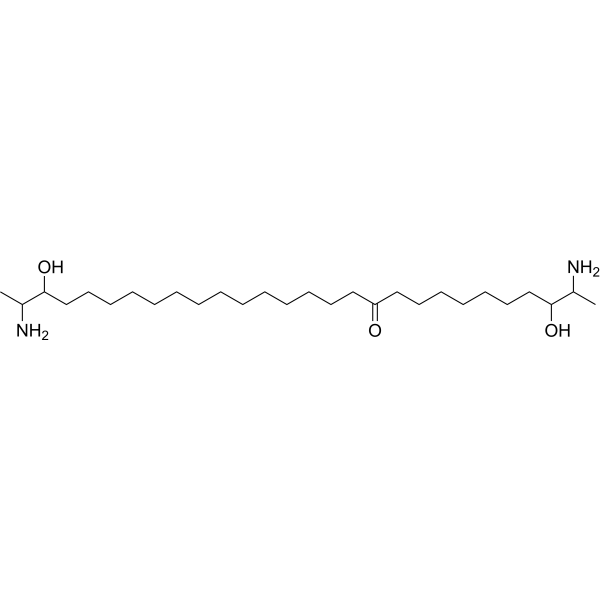
-
- HY-163193
-
|
|
Atg4
Autophagy
|
Cancer
|
|
MJO445 (Compound 7) is a ATG4B inhibitor, which inhibits the autophagy of glioblastoma .
|
-
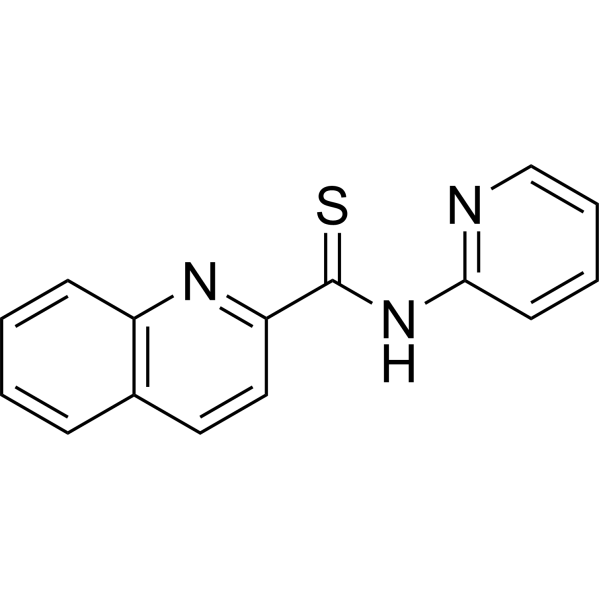
-
- HY-160055
-
|
|
Others
|
Cancer
|
|
GMT 4 aptamer sodium is a nucleic acid aptamer targeting different glioblastoma cell lines and exhibits high affinity. GMT 4 aptamer sodium also shows high binding affinity to the T lymphocyte cell line CCRF-CEM .
|
-
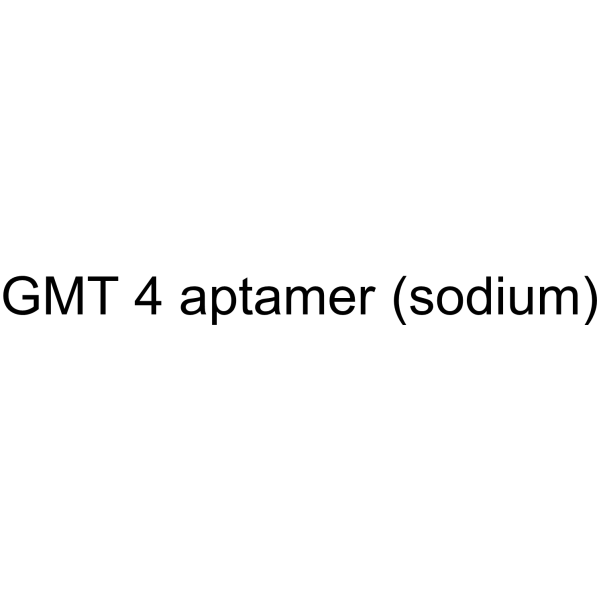
-
- HY-160057
-
|
|
Others
|
Cancer
|
|
GMT 8 aptamer sodium is a nucleic acid aptamer targeting different glioblastoma cell lines and exhibits high affinity. GMT 4 aptamer sodium also shows high binding affinity to the T lymphocyte cell line CCRF-CEM .
|
-

-
- HY-12401A
-
|
|
Mps1
|
Cancer
|
|
Mps1-IN-3 hydrochloride is a potent and selective Mps1 inhibitor with an IC50 value of 50 nM. Mps1-IN-3 hydrochloride can inhibit the proliferation of glioblastoma cells, and effectively sensitizes glioblastomas to Vincristine in orthotopic glioblastoma xenograft model .
|
-
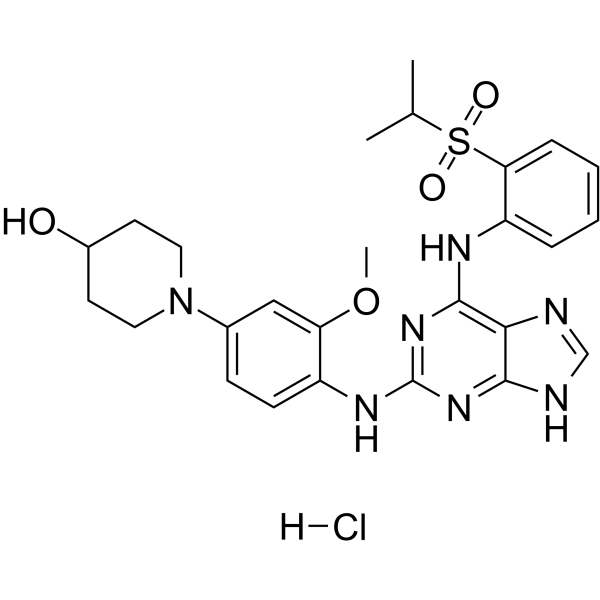
-
- HY-N12535
-
|
|
Others
|
Cancer
|
|
Tagitinin C is a sesquiterpenoid compound isolated from the Tithonia diversifolia. Tagitinin C has anticancer activity and can inhibit the proliferation of human glioblastoma U373 cells with an IC50 of 6.1 μg/mL. Tagitinin C can induce U373 cell death and be used in glioblastoma research .
|
-
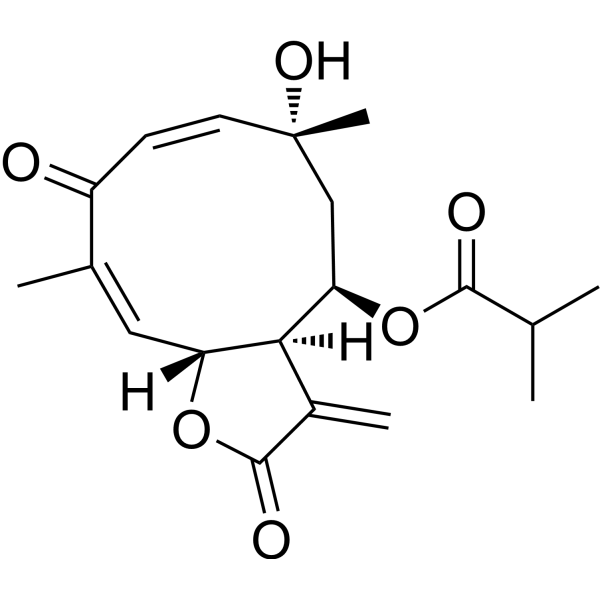
-
- HY-153773
-
|
|
IRE1
|
Cancer
|
|
Z4P is a BBB-permeable IRE1 inhibitor (IC50: 1.11 μM). Z4P inhibits Glioblastoma cell growth. Z4P prevents glioblastoma relapse when administered together with Temozolomide (HY-17364) .
|
-
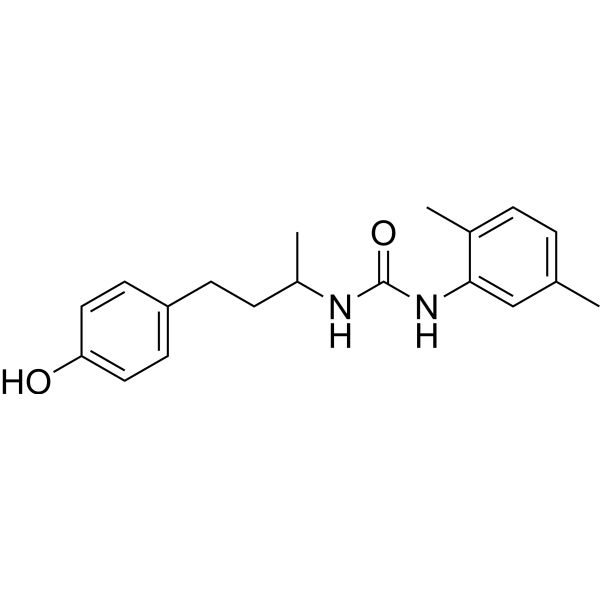
-
- HY-B0114S2
-
|
GP 47680-d8
|
Sodium Channel
Apoptosis
|
Neurological Disease
Cancer
|
|
Oxcarbazepine-d8-1 is a deuterium of Oxcarbazepine. Oxcarbazepine is a sodium channel blocker . Oxcarbazepine significantly inhibits glioblastoma cell growth and induces apoptosis or G2/M arrest in glioblastoma cell lines . Oxcarbazepine? has anti-cancer and anticonvulsant effects .
|
-

-
- HY-B0114
-
|
GP 47680
|
Sodium Channel
Apoptosis
|
Neurological Disease
Cancer
|
|
Oxcarbazepine is a sodium channel blocker . Oxcarbazepine significantly inhibits glioblastoma cell growth and induces apoptosis or G2/M arrest in glioblastoma cell lines . Anti-cancer and anticonvulsant effects .
|
-

-
- HY-155272
-
|
|
SHP2
|
Cancer
|
|
SHP2-IN-16 (compound 222) is a SHP2 inhibitor with an IC50 value of 1 nM. SHP2-IN-16 can be used for glioblastoma research .
|
-
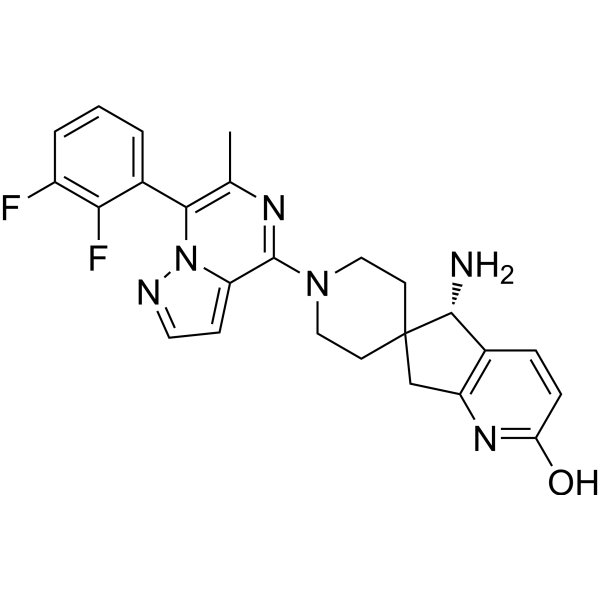
-
- HY-155273
-
|
|
SHP2
|
Cancer
|
|
SHP2-IN-17 (compound 192) is a SHP2 inhibitor with an IC50 value of 2 nM. SHP2-IN-17 can be used for glioblastoma research .
|
-

-
- HY-155274
-
|
|
SHP2
|
Cancer
|
|
SHP2-IN-18 (compound 183) is a SHP2 inhibitor with an IC50 value of 3 nM. SHP2-IN-18 can be used for glioblastoma research .
|
-
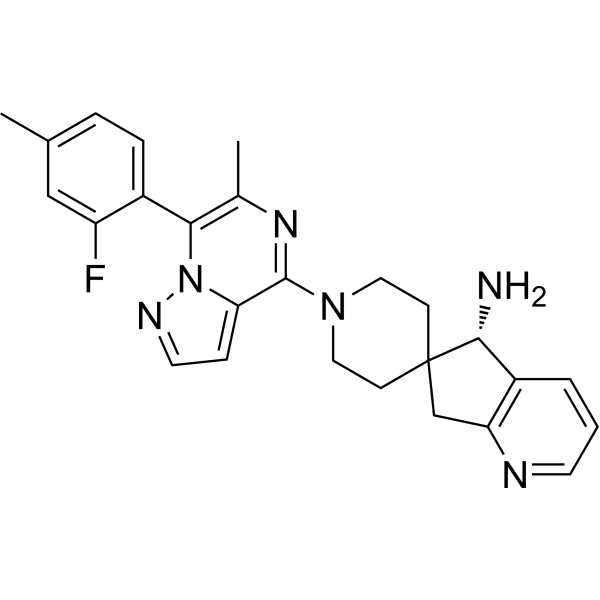
-
- HY-155275
-
|
|
SHP2
|
Cancer
|
|
SHP2-IN-19 (compound 183) is a SHP2 inhibitor with an IC50 value of 3 nM. SHP2-IN-19 can be used for glioblastoma research .
|
-
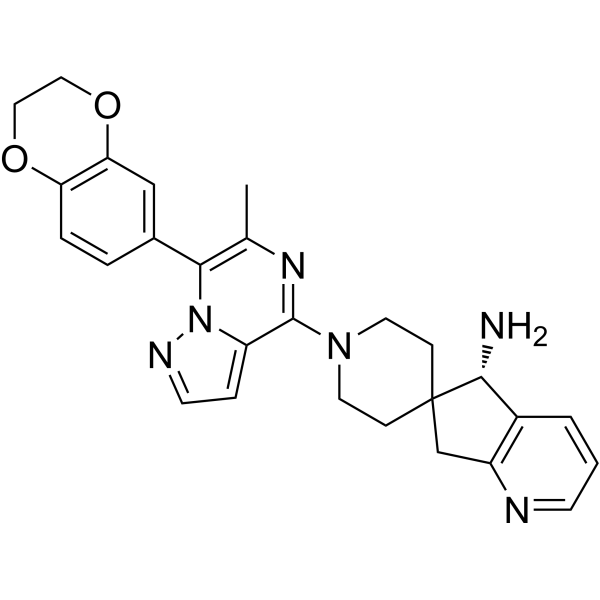
-
- HY-155276
-
|
|
SHP2
|
Cancer
|
|
SHP2-IN-20 (compound 193) is a SHP2 inhibitor with an IC50 value of 3 nM. SHP2-IN-20 can be used for glioblastoma research .
|
-
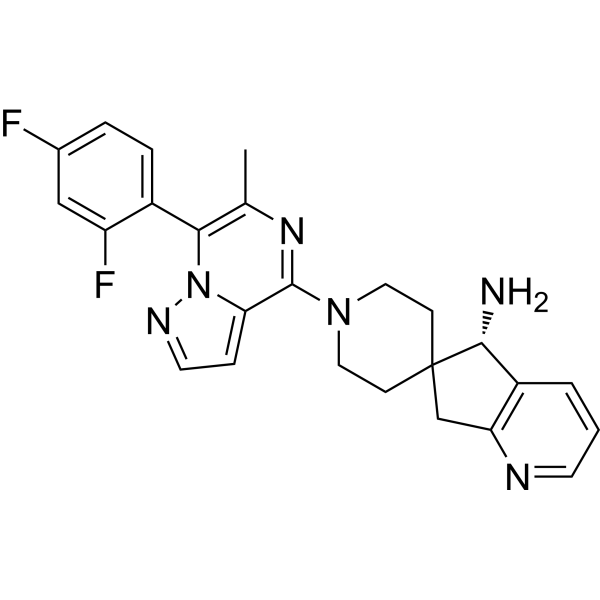
-
- HY-155277
-
|
|
SHP2
|
Cancer
|
|
SHP2-IN-21 (compound 208) is a SHP2 inhibitor with an IC50 value of 3 nM. SHP2-IN-21 can be used for glioblastoma research .
|
-
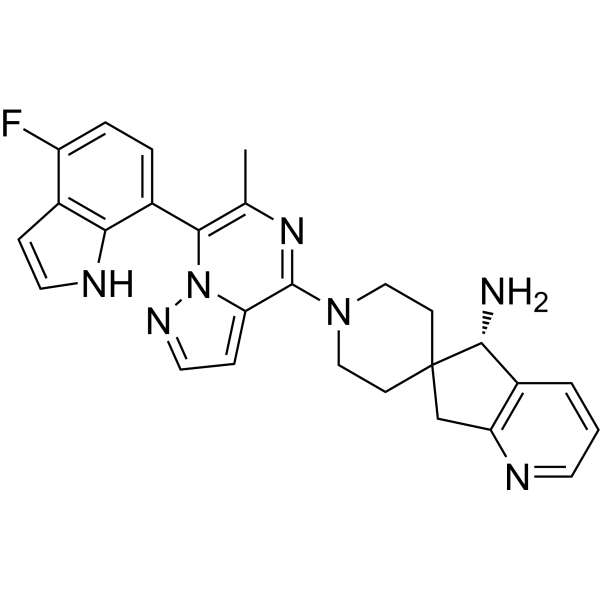
-
- HY-157975
-
|
|
Glutaminase
|
Cancer
|
|
LM11 is an inhibitor of transglutaminase 2 (TG2) with an activity of killing glioblastoma cells by maintaining TG2 in a cytotoxic conformational state .
|
-
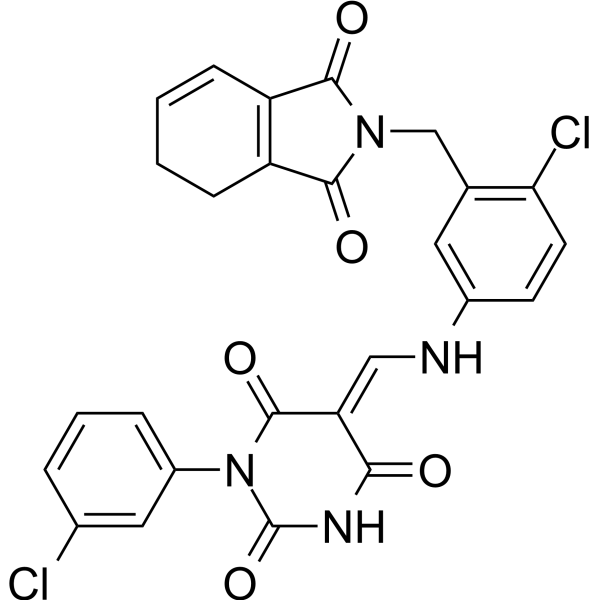
-
- HY-147637
-
|
|
Ephrin Receptor
|
Cancer
|
|
EphA2 agonist 1 (Compound 7bg) is a potent EphA2 receptor agonist. EphA2 agonist 1 shows great potency and selectivity toward EphA2 overexpressed glioblastoma cells and stimulates EphA2 phosphorylation .
|
-
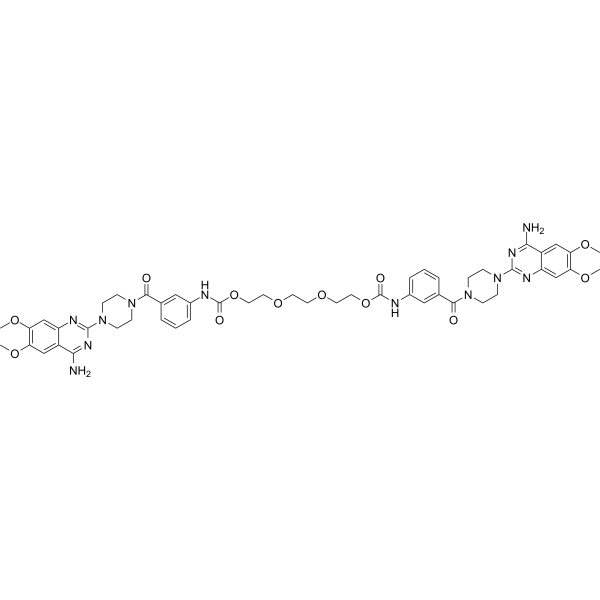
-
- HY-150124
-
|
|
Integrin
|
Cancer
|
|
K34c is a potent and selective α5β1 integrin antagonist. K34c can be used for glioblastoma research .
|
-
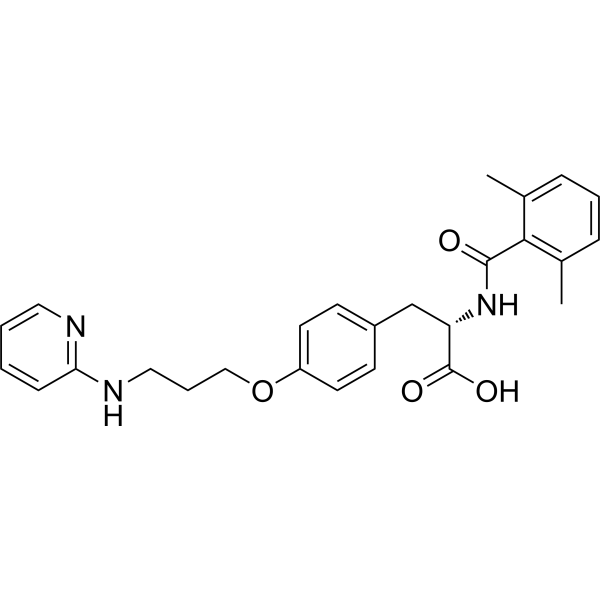
-
- HY-N8835
-
-
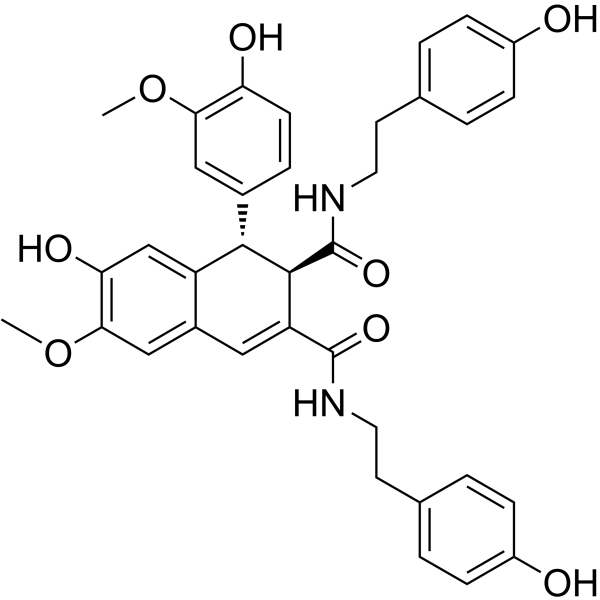
-
- HY-19345A
-
|
NSC13316 dihydrochloride
|
Others
|
Cancer
|
|
Vacquinol-1 (NSC13316) dihydrochloride is a MKK4-specific activator that activates MAPK pathways . Vacquinol-1 dihydrochloride specifically induces human glioblastoma cell (GC) death, attenuates tumor progression and prolongs survival in a glioblastoma multiforme (GBM) mouse model . Vacquinol-1 dihydrochloride also induces apoptosis in hepatocellular carcinoma (HCC)cell .
|
-
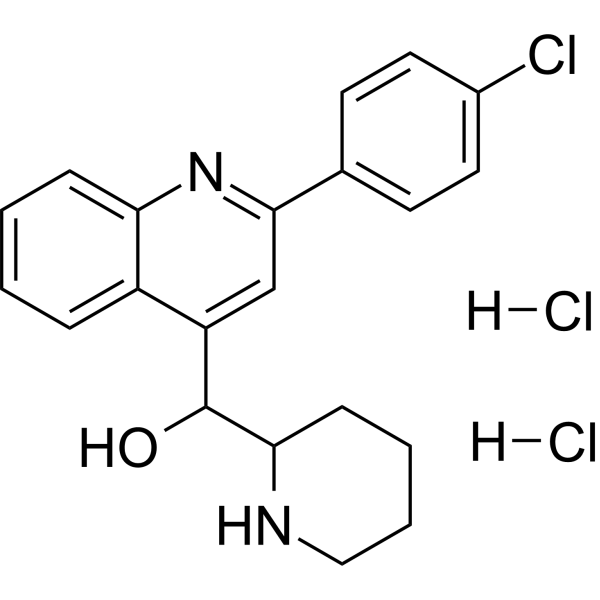
-
- HY-125427
-
|
|
OLIG2
|
Cancer
|
|
SKOG102 is a potent OLIG2 inhibitor that is directly engaging OLIG2 and interferes with the ability of OLIG2 to bind DNA. SKOG102 can be used for the research of glioblastoma (GBM) .
|
-

-
- HY-120115
-
|
Olaparib-bodipy FL
|
PARP
|
Cancer
|
|
PARPi-FL is a small molecule and fluorescent inhibitor of PARP1. PARPi-FL is a highly selective probe and can be used as an imaging agent to detect glioblastomas in vivo .
|
-
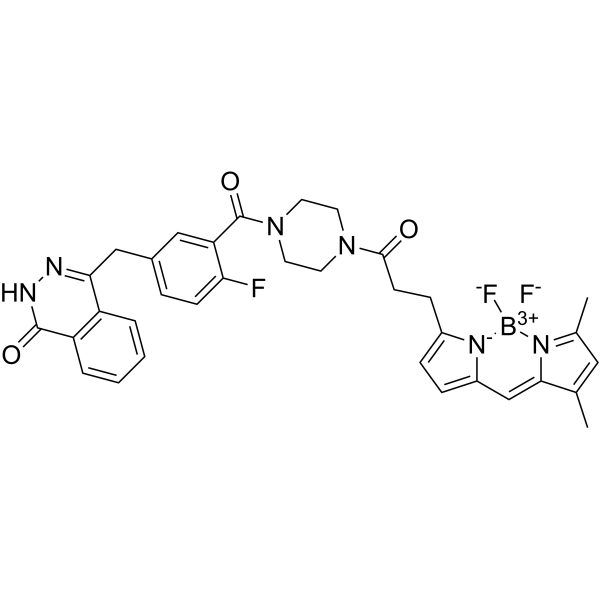
-
- HY-149515
-
|
|
Monoamine Oxidase
|
Cancer
|
|
MAO-IN-3 (Compound 5) is a reversible and competitive MAO inhibitor (Ki: 0.6 and 0.2 μM for MAO A and MAO B). MAO-IN-3 inhibits LN-229 glioblastoma cell proliferation with an IC50 of 0.8 μM. MAO-IN-3 can be used for cancer research .
|
-

-
- HY-161256
-
|
|
Microtubule/Tubulin
Apoptosis
|
Cancer
|
|
Tubulin inhibitor 41 (Compd D19), a promising anti-GBM (glioblastoma) lead compound and tublin inhibitor with BBB permeability, induces G2/M phase arrest, resulted in cell apoptosis and inhibits the migration of U87 cells .
|
-

-
- HY-P5297
-
|
|
CXCR
|
Cancer
|
|
DOTA-CXCR4-L is a CXCR4 targeting peptide. DOTA-CXCR4-L can be used in the study of cancers, including glioblastoma and triple-negative breast cancer .
|
-
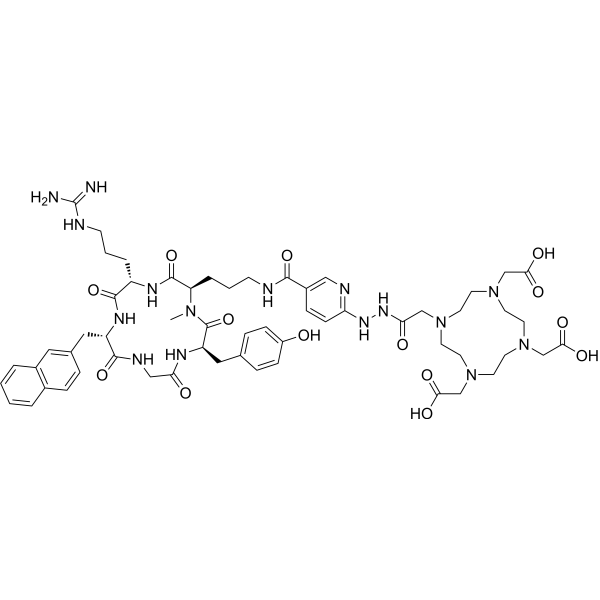
-
- HY-154910
-
|
|
mTOR
|
Cancer
|
|
CC214-1 is a potentially efficacious mTOR inhibitor that induces autophagy ,with an IC50 is 0.002 μM. CC214-1 proved to be useful as an in vitro tool compound for the exploration of mTOR kinase biology. CC214-1 can be used for Glioblastoma study .
|
-

-
- HY-12616
-
|
|
LPL Receptor
|
Cancer
|
|
ACT-209905 is a S1P1 receptor agonist. ACT-209905 can inhibit glioblastoma (GBM) cell growth and migration. ACT-209905 also has immunomodulating activity, and can be used in research of autoimmune diseases .
|
-

-
- HY-142682
-
|
|
Others
|
Neurological Disease
Cancer
|
|
SCP1-IN-1 (compound SH T-62) is a potent and selective covalent inhibitor against SCP1. SCP1-IN-1 promotes REST degradation and reduces transcriptional activity. A high level of REST protein drives the tumor growth in some glioblastoma cells. SCP1-IN-1 has the potential for the research of glioblastoma whose growth is driven by REST transcription activity .
|
-
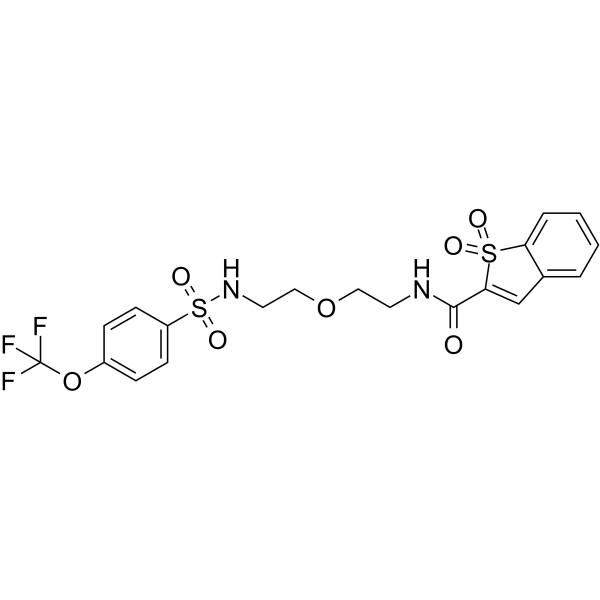
-
- HY-142683
-
|
|
Others
|
Neurological Disease
Cancer
|
|
SCP1-IN-2 (Compound SH T-65) is a potent and selective covalent inhibitor against SCP1. SCP1-IN-2 promotes REST degradation and reduces transcriptional activity. A high level of REST protein drives the tumor growth in some glioblastoma cells. SCP1-IN-2 has the potential for the research of glioblastoma whose growth is driven by REST transcription activity .
|
-
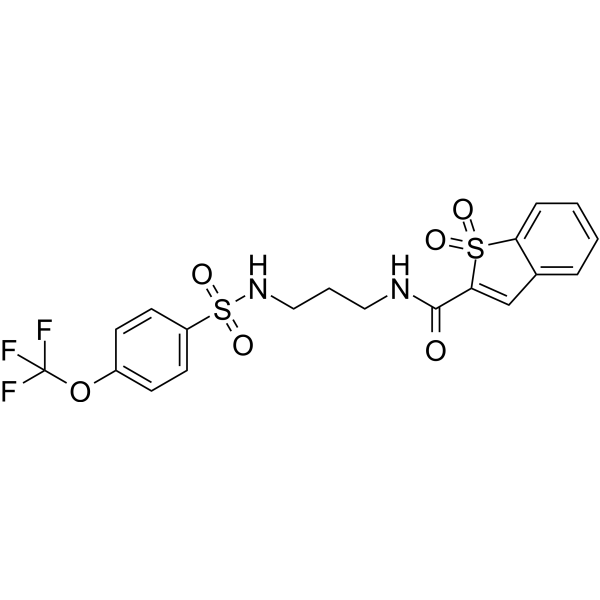
-
- HY-133570
-
|
|
HSP
ADC Cytotoxin
|
Cancer
|
|
17-AEP-GA, an HSP90 antagonist, is a potent inhibitor of glioblastoma cell proliferation, survival, migration and invasion. ADCs Toxin .
|
-

-
- HY-112293
-
|
|
EGFR
|
Cancer
|
|
GW2974 is a potent dual inhibitor of EGFR and HER2 with IC50 value of 0.007 μM and 0.016 μM, respectively. GW2974 demonstrates in vitro inhibition of the EGFR and HER2 and inhibits the growth of tumor cell. GW2974 can be used for glioblastoma multiforme (GBM) disease research .
|
-

-
- HY-125964
-
|
|
Survivin
|
Cancer
|
|
LLP-3 is a potent Survivin inhibitor that disrupts the Survivin-Ran interaction in cancer cells. LLP-3 can be used in the research of Glioblastoma multiforme (GBM) .
|
-

-
- HY-149374
-
|
|
Microtubule/Tubulin
|
Cancer
|
|
Tubulin inhibitor 36 (Compound 10) is a novel and potent tubulin inhibitor and inhibits the polymerization of microtubular protein then induces apoptosis with an IC50 value of 1.5±0.1 μM. Tubulin inhibitor 36 (Compound 10) has significant anti-mitotic effect and exhibits activities against glioblastoma cells. Tubulin inhibitor 36 (Compound 10) has anti-tumor effects and can be used for glioblastoma multiforme (GBM) research .
|
-
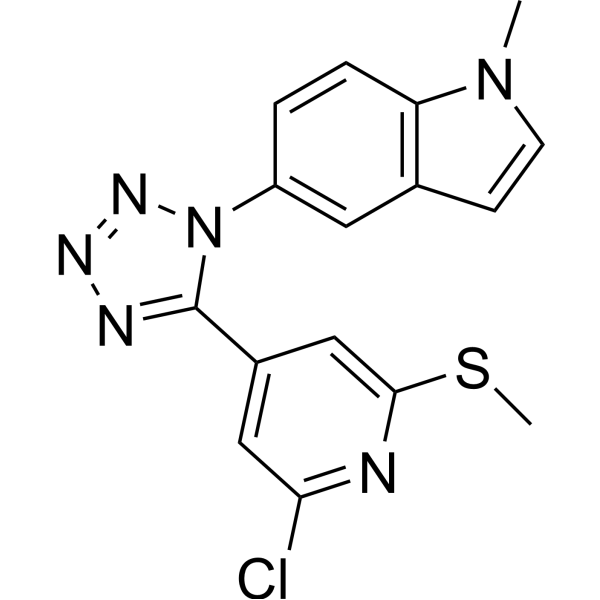
-
- HY-152203
-
|
|
Others
|
Cancer
|
|
Mitochondrial respiration-IN-2 is the fluorine derivative of Virginiamycin M1 (HY-N6686). Mitochondrial respiration-IN-2 can inhibit mitochondrial translation of glioblastoma stem cells .
|
-
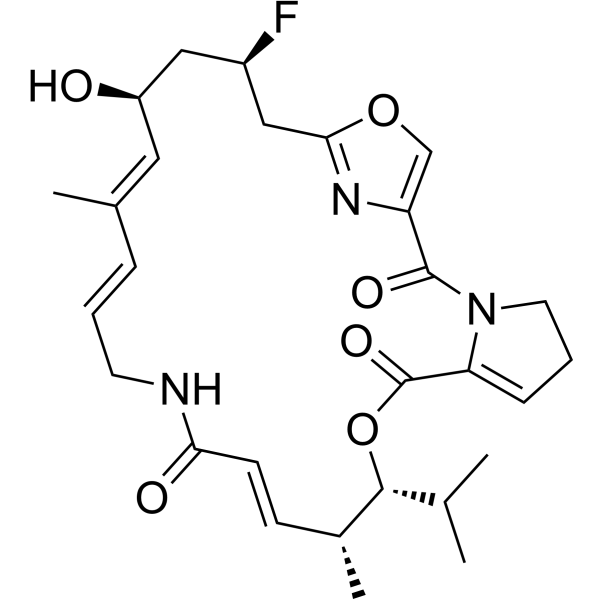
-
- HY-P99908
-
|
NT-17
|
Interleukin Related
|
Cancer
|
|
Efineptakin alfa (NT-17) is a long-acting recombinant human IL-7. Efineptakin alfa supports the proliferation and survival CD4 + and CD8 + cells in both human and mice. Efineptakin alfa can be used for glioblastoma research .
|
-

-
- HY-17595
-
|
|
Parasite
Apoptosis
Microtubule/Tubulin
|
Infection
Cancer
|
|
Mebendazole is a highly effective, broad-spectrum antihelmintic against nematode infestations. Mebendazole also exhibits inhibitory effect against glioblastoma multiforme (GBM), inhibits Hedgehog pathway and tubulin polymerization. Mebendazole is orally active and can cross CNS penetration .
|
-
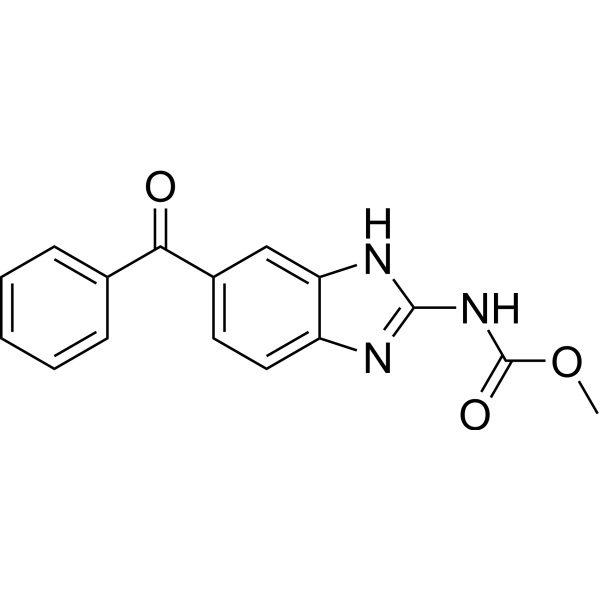
-
- HY-103407
-
|
|
Dopamine Receptor
|
Neurological Disease
Cancer
|
|
PD 168568 is a orally active and potent dopamine receptor D4 (DRD4) antagonist. PD 168568 contains an isoindolinone and is selective for the D4 receptor versus D2 and D3, with Ki values of 8.8, 1842, and 2682 nM, respectively. PD 168568 can be used for glioblastoma (GBM) research .
|
-
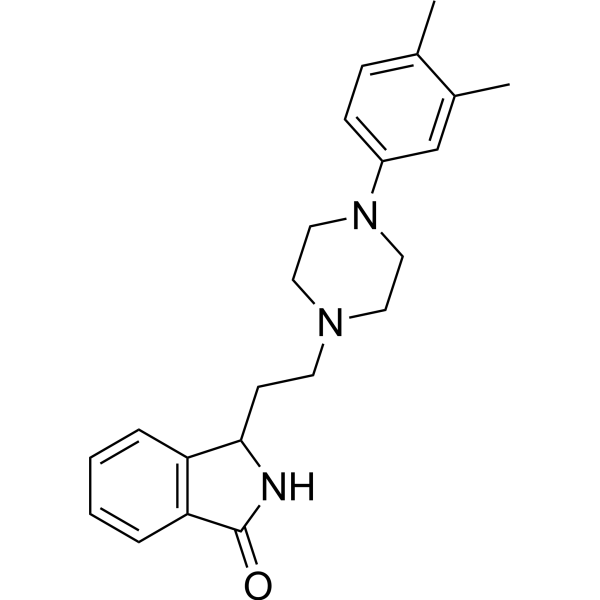
-
- HY-124582
-
|
|
Autophagy
mTOR
|
Cancer
|
|
NEO214 is an autophagy inhibitor and a covalent conjugate of the PDE4 inhibitor Rolipram (HY-16900) and perillyl alcohol (HY-N7000). It has anti-cancer activity and blood-brain barrier (BBB) permeability. Over sex. NEO214 prevents autophagy-lysosome fusion, thereby blocking autophagic flux and triggering glioma cell death. The process involves mTOR activation, andTFEB(Transcription Factor EB) aggregation. NEO214 inhibitionMacroautophagy/autophagy in glioblastoma cells has the potential to overcome chemotherapy resistance in glioblastoma .
|
-

-
- HY-P99223
-
|
MEDI-575
|
PDGFR
|
Cancer
|
|
Tovetumab (MEDI-575) is an anti-PDGFRα monoclonal antibody that selectively blocks the PDGFRα signal transduction. Tovetumab can be used in the research of glioblastoma and non-small cell lung cancer (NSCLC) .
|
-
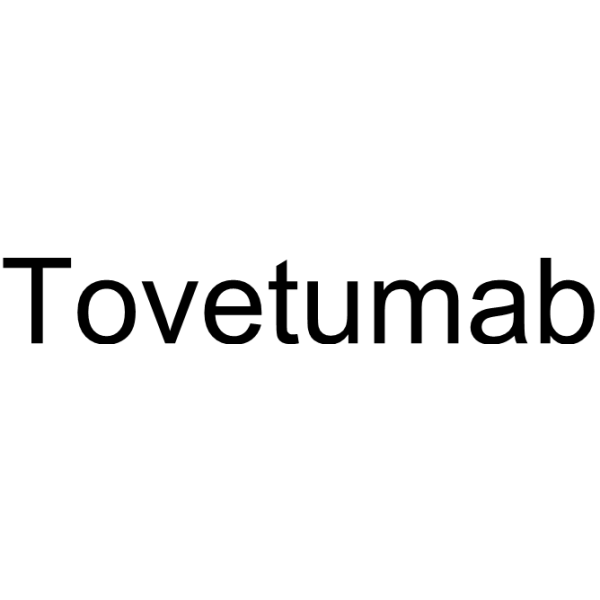
-
- HY-155532
-
|
|
Biochemical Assay Reagents
|
Cancer
|
|
10m/ZS44 is a blood-brain barrier-permeable Glioblastoma (GBM) inhibitor. 10m/ZS44 significantly inhibits GBM tumor growth in a mouse xenograft model. 10m/ZS44 also activates the SIRT1/p53-mediated apoptosis pathway, thereby inhibiting the proliferation of U251 cells .
|
-

-
- HY-156432
-
|
|
Anaplastic lymphoma kinase (ALK)
mTOR
PARP
Caspase
|
Cancer
|
|
ALK-IN-26 is an ALK inhibitor with IC50 value of 7.0 μM for ALK tyrosine kinase. ALK-IN-26 has good pharmacokinetic properties and blood-brain barrier (BBB) permeability. ALK-IN-26 can induce apoptosis, autophagy and necrosis. ALK-IN-26 can be used in glioblastoma studies .
|
-
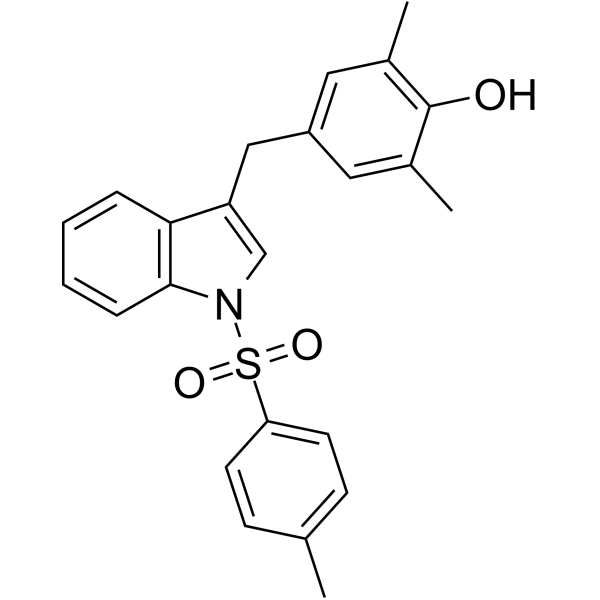
-
- HY-153627
-
|
|
Deubiquitinase
|
Cancer
|
|
G13KS is a deubiquitinase UCHL1 ligand and inhibitor. G13KS inhibits recombinant and cellular UCHL1. G13KS reduces levels of monoubiquitin in human glioblastoma cells . GK13S is a click chemistry reagent, it contains an Alkyne group and can undergo copper-catalyzed azide-alkyne cycloaddition (CuAAc) with molecules containing Azide groups.
|
-
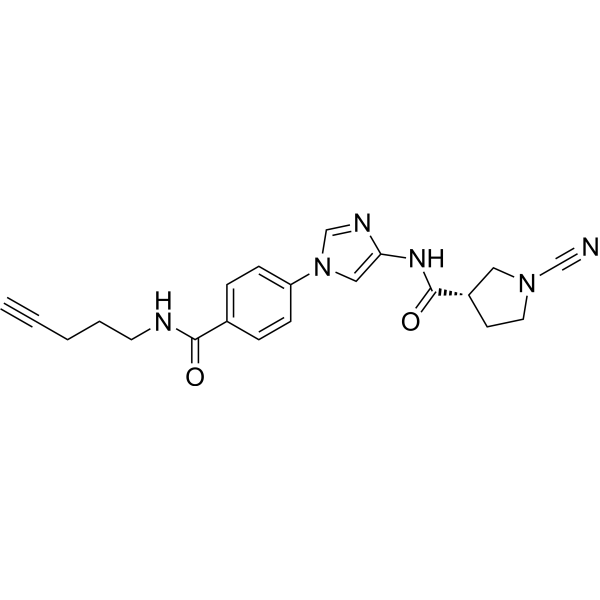
-
- HY-147327
-
|
|
Others
|
Cancer
|
|
N-Formylsarcolysine has antitumor activity, and inhibits leukemia by increasing the Hb and erythrocyte levels and decreasing the number of leukocytes. N-Formylsarcolysine also involves in glioblastoma and other diseases research .
|
-
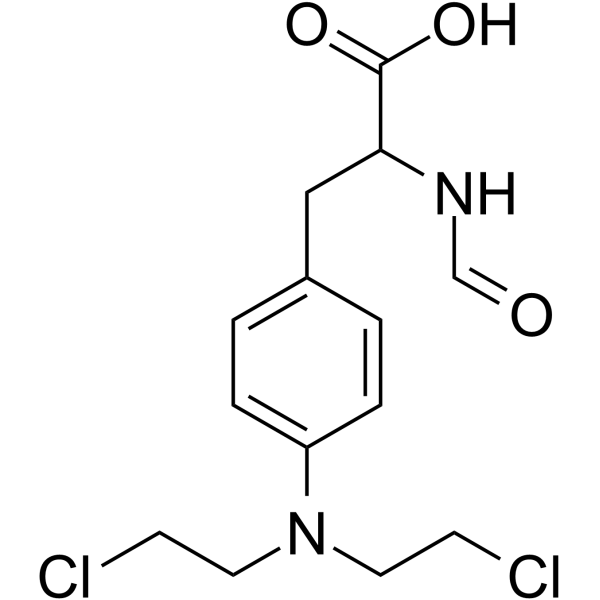
-
- HY-P3990
-
|
|
VEGFR
Autophagy
Apoptosis
|
Cancer
|
|
Coibamide A, an N-methyl-stabilized cytotoxic depsipeptide, shows potent antiproliferative activity. Coibamide A induces autophagosome accumulation via an mTOR-independent mechanism. Coibamide A induces apoptosis. Coibamide A inhibits VEGFA/VEGFR2 expression and suppresses tumor growth in glioblastoma xenografts .
|
-
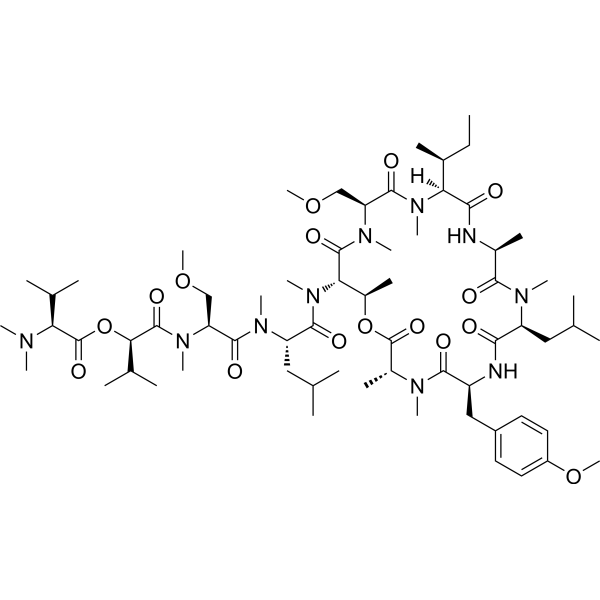
-
- HY-146320
-
|
|
Chloride Channel
|
Cancer
|
|
ANO1-IN-1 (Compound 9c) is a selective ANO1 channel blocker with an IC50 of 2.56 μM and 15.43 μM against ANO1 and ANO2, respectively. ANO1-IN-1 suppresses strongly proliferation of glioblastoma cells .
|
-
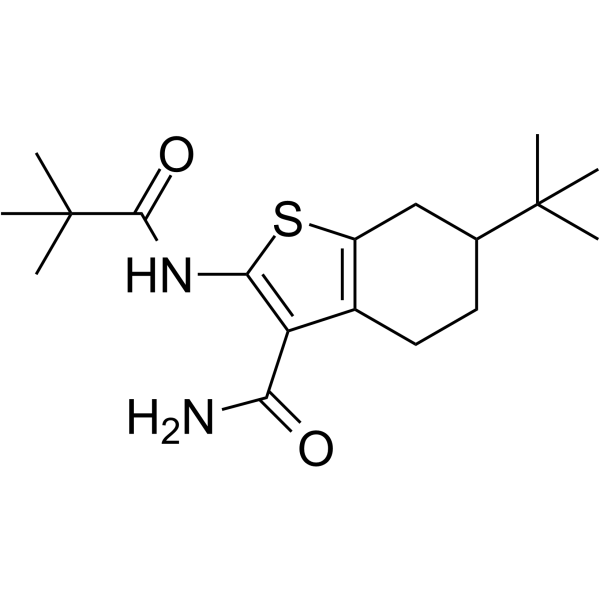
-
- HY-146321
-
|
|
Chloride Channel
|
Cancer
|
|
ANO1-IN-2 (Compound 10q) is a selective ANO1 channel blocker with an IC50 of 1.75 μM and 7.43 μM against ANO1 and ANO2, respectively. ANO1-IN-2 suppresses strongly proliferation of glioblastoma cells .
|
-
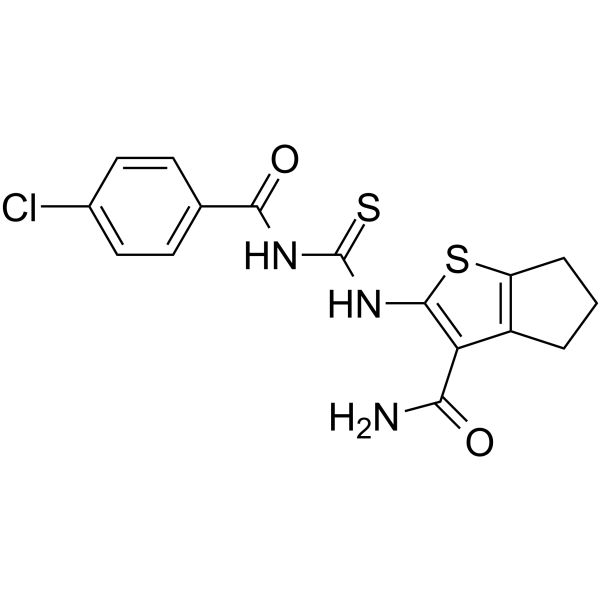
- HY-114413
-
|
|
HSP
Apoptosis
|
Cancer
|
|
YZ129 is an inhibitor of the HSP90-calcineurin-NFAT pathway against glioblastoma, directly binding to heat shock protein 90 (HSP90) with an IC50 of 820 nM on NFAT nuclear translocation. YZ129-induced GBM cell-cycle arrest at the G2/M phase promotes apoptosis and inhibited tumor cell proliferation and migration .
|
-

- HY-152202
-
|
|
Mitochondrial Metabolism
|
Cancer
|
|
Mitochondrial respiration-IN-3 is the fluorine derivative of Dalfopristin (HY-A0241). Mitochondrial respiration-IN-3 has cell membrane-permeable. Mitochondrial respiration-IN-3 can inhibit mitochondrial translation of glioblastoma stem cells. Mitochondrial respiration-IN-3 can be used in research of cancer .
|
-
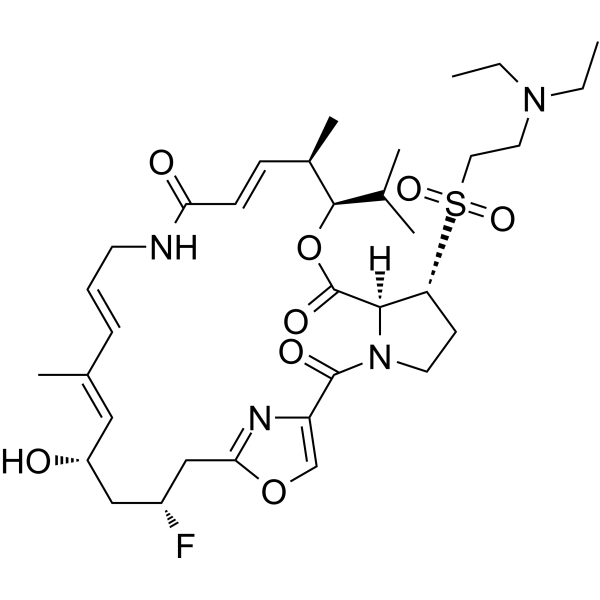
- HY-146275
-
|
|
LXR
|
Cancer
|
|
LXRβ agonist-3 (compound 4-13) is a potent and selective LXRβ (liver X receptor β) agonist, with an EC50 of 0.095 μM. LXRβ agonist-3 efficiently inhibits U87EGFRvIII cell, with an IC50 of 3.75 μM. LXRβ agonist-3 shows antitumor activity, and can inhibit glioblastoma .
|
-

- HY-13440
-
AMG 511
2 Publications Verification
|
PI3K
|
Cancer
|
|
AMG 511 is a potent and orally available pan inhibitor of class I PI3Ks, with Kis of 4 nM, 6 nM, 2 nM and 1 nM for PI3Kα, β, δ and γ, respectively. AMG 511 significantly suppresses PI3K signaling that is indicated by p-Akt (Ser473) decrease. AMG 511 exhibits anti-tumor activity in mouse glioblastoma xenograft model .
|
-
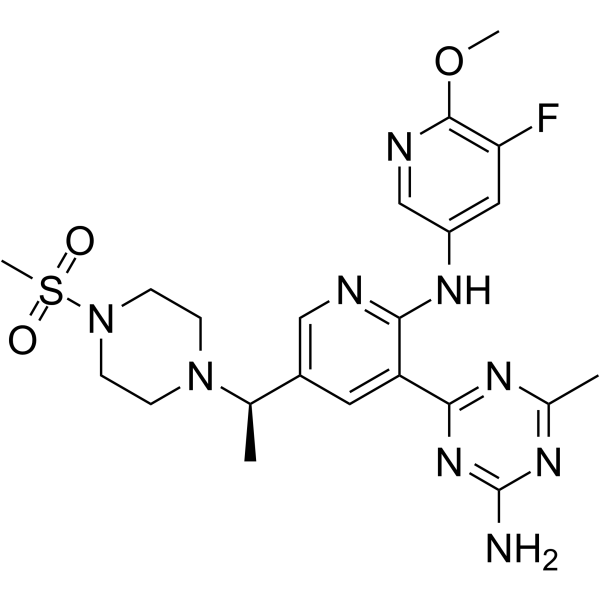
- HY-N0421
-
|
Cinobufagine
|
Apoptosis
|
Neurological Disease
Cancer
|
|
Cinobufagin is an anticancer agent that can be secreted by the Asiatic toad Bufo gargarizans. Cinobufagin induces the cell cycle arrests in the G1 phase or G2/M phase, leading to apoptosis in cancer cells. Cinobufagin inhibits tumor growth in melanoma and glioblastoma multiforme xenograft mouse models .
|
-

- HY-115670
-
|
|
MMP
|
Inflammation/Immunology
Cancer
|
|
GW280264X is the mixed ADAM10/TACE (ADAM17) metalloproteinases inhibitor. GW280264X potently blocks TACE (ADAM17) and ADAM10 with IC50s of 8.0 nM and 11.5 nM, respectively . ADAM10 and 17 modulate the immunogenicity of glioblastoma-initiating cells .
|
-

- HY-147011
-
|
|
Fat Mass and Obesity-associated Protein (FTO)
|
Cancer
|
|
FTO-IN-7 is an inhibitor of FTO. FTO-IN-7 can be used in study Alzheimer's diseases, breast cancers, small-cell lung cancers,a human bone marrow striated muscle cancer, a pancreatic cancer, malignant glioblastoma .
|
-

- HY-111449
-
|
AHR antagonist 1
|
Aryl Hydrocarbon Receptor
|
Inflammation/Immunology
Cancer
|
|
BAY-218 (AHR antagonist 1) is an aryl hydrocarbon receptor (AHR) antagonist. BAY-218 has AHR inhibitory activity with an IC50 of 39.9 nM in in U87 glioblastoma cells. BAY-218 can be used for the research of cancer or conditions with dysregulated immune responses .
|
-
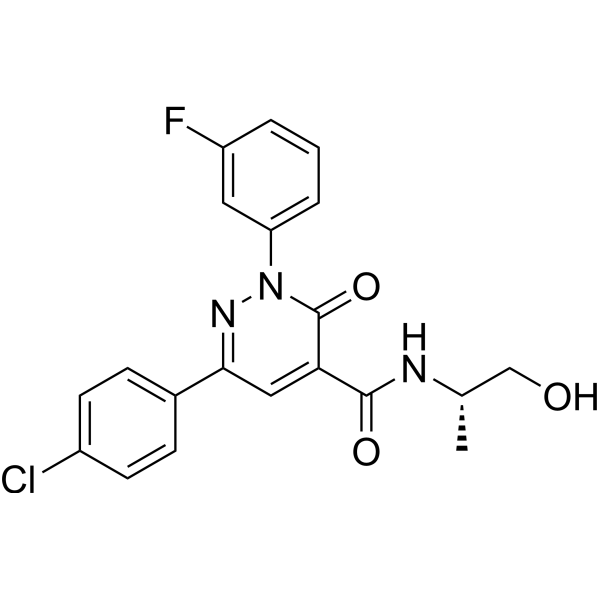
- HY-103190
-
|
|
Adenosine Receptor
|
Neurological Disease
Cancer
|
|
MRS1220, a highly potent and selective human A3 adenosine receptor (hA3AR) antagonist with a Ki of 0.59 nM, has therapeutic potential for the research of diseases of the central nervous system . MRS1220 reduces glioblastoma tumor size and blood vessel formation in vivo .
|
-

- HY-108476
-
INDY
2 Publications Verification
|
DYRK
|
Cancer
|
|
INDY is a potent and ATP-competitive Dyrk1A and Dyrk1B inhibitor with IC50s of 0.24 μM and 0.23 μM, respectively. INDY binds in the ATP pocket of the enzyme and has a Ki value of 0.18 μM for Dyrk1A. INDY sharply reduces the self-renewal capacity of normal and tumorigenic cells in primary Glioblastoma (GBM) cell lines and neural progenitor cells .
|
-
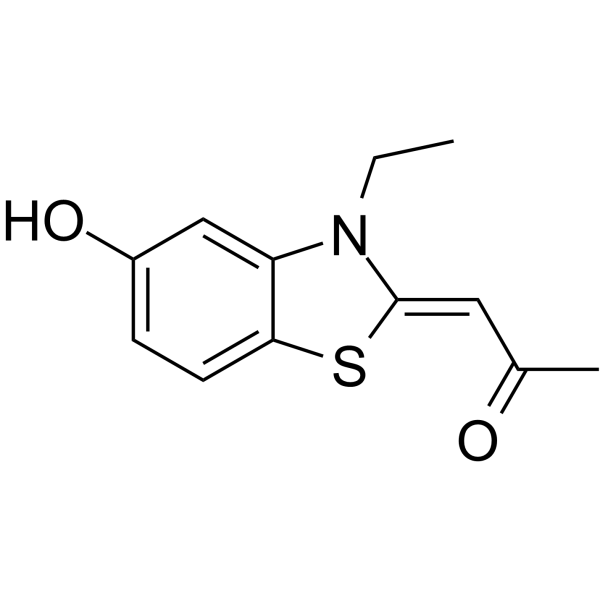
- HY-P3103
-
|
|
DNA/RNA Synthesis
|
Cancer
|
|
PINT-87aa, an 87-amino acid (aa) peptide, is encoded by the circular form of the long intergenic non-protein-coding RNA p53-induced transcript (LINC-PINT). PINT-87aa directly interacts with polymerase associated factor complex (PAF1c) and inhibits the transcriptional elongation of multiple oncogenes. PINT-87aa suppresses glioblastoma cell proliferation in vitro and in vivo .
|
-

- HY-19939S
-
VX-984
4 Publications Verification
M9831
|
DNA-PK
|
Cancer
|
|
VX-984 is an orally active, potent, selective and BBB-penetrated DNA-PK inhibitor. VX-984 efficiently inhibits NHEJ (non-homologous end joining) and increases DSBs (DNA double-strand breaks). VX-984 can be used for glioblastomas (GBM) and non-small cell lung cancer (NSCLC) research. VX-984 is a de novo deuterium .
|
-
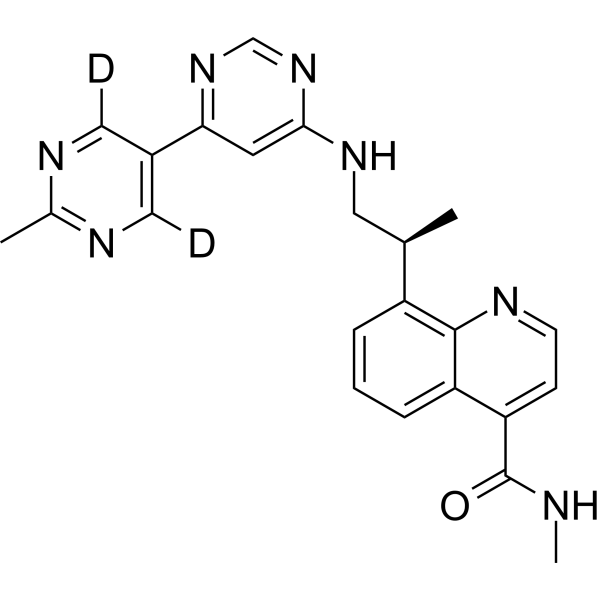
- HY-148114
-
|
|
Others
|
Cancer
|
|
MOPIPP is a novel indolebased chalcone, and vacuolin-1, is a non-lethal vacuoleinducing 2-propyl analog of MOMIPP (HY-148114). MOPIPP induces cellular vacuolization and increases autophagosomes numbers. MOPIPP also triggers methuosis, and interrupts glucose uptake and glycolytic metabolism. MOPIPP can cross the blood-brain barrier and shows efficacy in suppressing tumor progression agaisnt glioblastoma cells .
|
-

- HY-P3103A
-
|
|
DNA/RNA Synthesis
|
Cancer
|
|
PINT-87aa TFA, an 87-amino acid (aa) peptide, is encoded by the circular form of the long intergenic non-protein-coding RNA p53-induced transcript (LINC-PINT). PINT-87aa TFA directly interacts with polymerase associated factor complex (PAF1c) and inhibits the transcriptional elongation of multiple oncogenes. PINT-87aa TFA suppresses glioblastoma cell proliferation in vitro and in vivo .
|
-

- HY-147789
-
|
|
Akt
|
Neurological Disease
Cancer
|
|
FPDT is an anti-glioblastoma agent. FPDT displays the IC50 value of 45–68 μM for GBM cells and >100 μM for astrocytes. Anti-glioblastoma activity of FPDT is linked to downregulation of the AKT pathway .
|
-

- HY-P4115
-
|
|
FABP
|
Cancer
|
|
CooP is a linear glioblastoma-targeting nonapeptide. CooP binds to the mammary-derived growth inhibitor/fatty acid binding protein 3 (FABP3) in the glioblastoma cells and its associated vasculature. CooP is used for the targeted delivery of chemotherapy and different nanoparticles .
|
-

- HY-132865
-
-
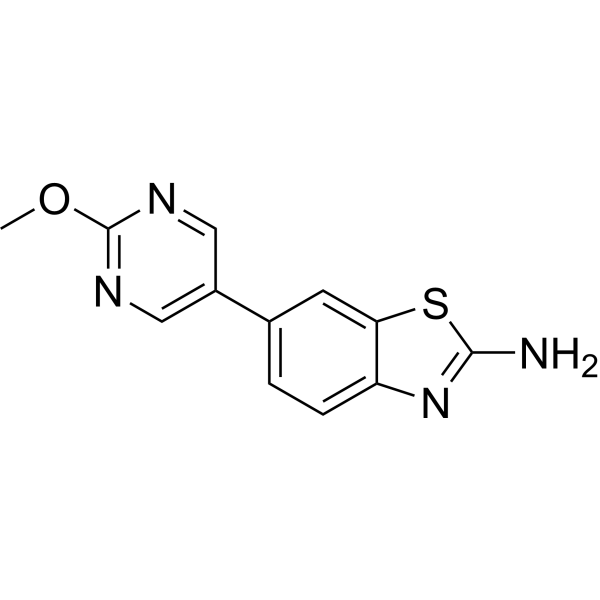
- HY-132863
-
-

- HY-124813
-
|
113B7
|
FAK
EGFR
MMP
|
Cancer
|
|
PDZ1i is a potent, BBB-penetrated and specific MDA-9/Syntenin inhibitor. PDZ1i inhibits crucial GBM (glioblastoma multiforme) signaling involving FAK and EGFRvIII. PDZ1i reduces MMP secretion. PDZ1i can improve survival of brain tumor-bearing mice and reduce tumor invasion .
|
-
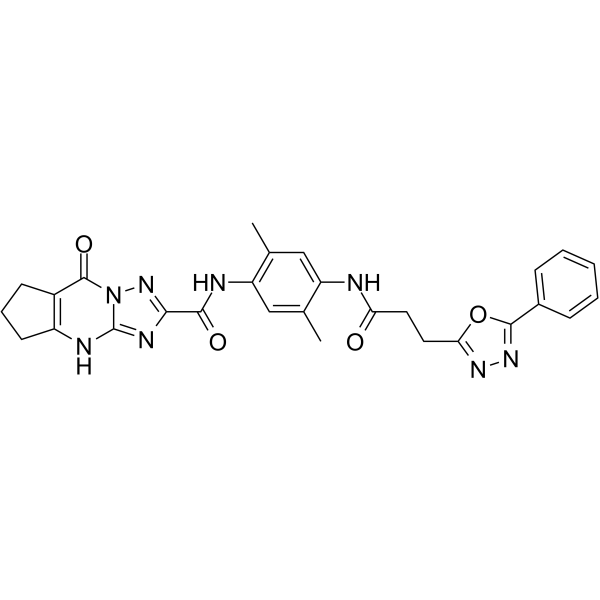
- HY-B0114S1
-
-

- HY-122910
-
|
|
Apoptosis
|
Cancer
|
|
RIPGBM is a selective inducer of apoptosis in glioblastoma multiforme (GBM) cancer stem cells (CSCs) with an EC50 of ≤500 nM .
|
-
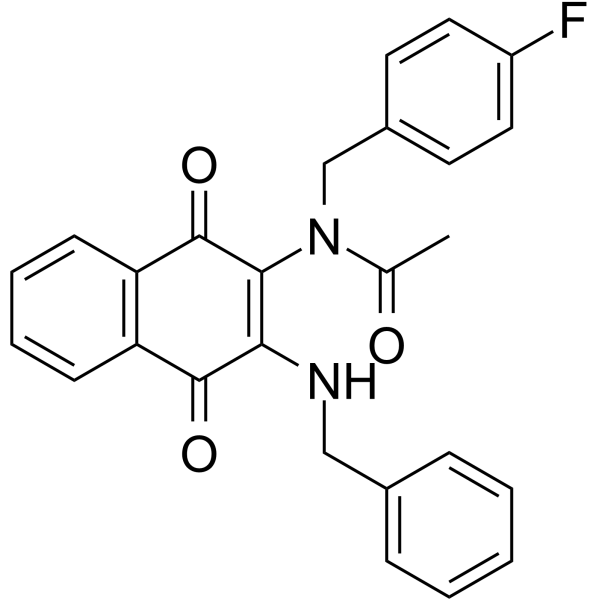
- HY-16173
-
-
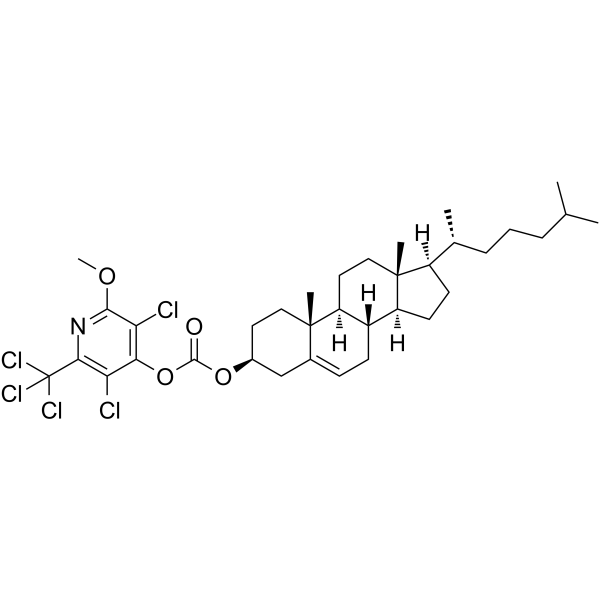
- HY-B0114S
-
|
GP 47680-d4
|
Sodium Channel
Apoptosis
|
Neurological Disease
Cancer
|
|
Oxcarbazepine-d4 (GP 47680-D4) is the deuterium labeled Oxcarbazepine. Oxcarbazepine is a sodium channel blocker[1]. Oxcarbazepine significantly inhibits glioblastoma cell growth and induces apoptosis or G2/M arrest in glioblastoma cell lines[2]. Anti-cancer and anticonvulsant effects[2][3].
|
-

- HY-19345
-
|
NSC13316
|
|
|
|
Vacquinol-1 (NSC13316) is a MKK4-specific activator that activates MAPK pathways . Vacquinol-1 specifically induces human glioblastoma cell (GC) death, attenuates tumor progression and prolongs survival in a glioblastoma multiforme (GBM) mouse model . Vacquinol-1 also induces apoptosis in hepatocellular carcinoma (HCC)cell .
|
-
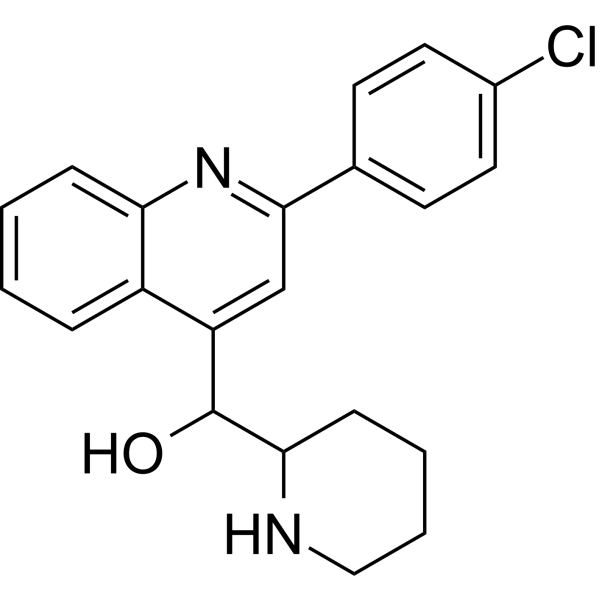
- HY-111652
-
|
|
Others
|
Cancer
|
|
S-Gboxin, a functional analogue of Gboxin, inhibits growth of mouse and human glioblastoma (GBM) with an IC50 of 470 nM . Antitumour activity .
|
-
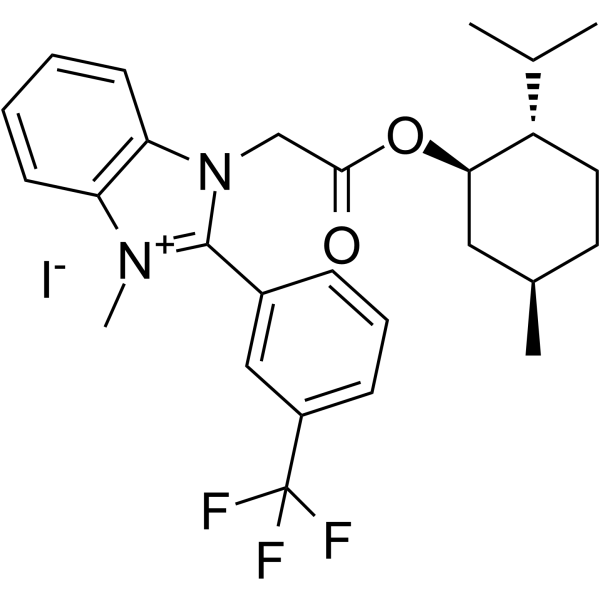
- HY-13610
-
|
|
Caspase
|
Cancer
|
|
N1,N11-Diethylnorspermine (DENSPM) is a potent anticancer agent. N1,N11-Diethylnorspermine is a spermine analog that activates polyamine catabolism. N1,N11-Diethylnorspermine induces the release of cytochrome c from mitochondria, resulting in activation of caspase 3. N1,N11-Diethylnorspermine kills glioblastoma multiforme (GBM) cells through induction of SSAT (spermidine/spermine N1-acetyltransferase) coupled with H2O2 production .
|
-
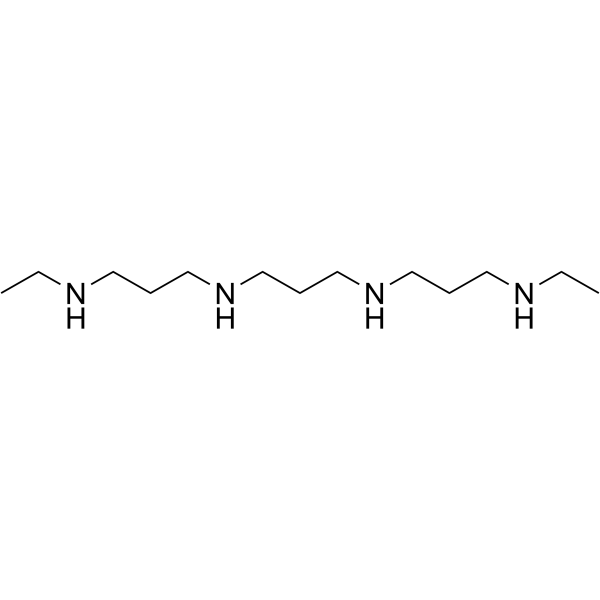
- HY-155577
-
|
|
Monoamine Oxidase
HSP
|
Cancer
|
|
MAO A/HSP90-IN-1 (4-b) is a MAO A/HSP90 dual inhibitor with IC50 value of 1.77 μM and 0.019 μM in Glioblastoma (GBM) GL26 cells and HSP90α, respectively. MAO A/HSP90-IN-1 (4-b) can inhibit MAO A activity, HSP90 binding and the expression of HER2 and phospho-Akt to inhibit the growth of GBM, they also reduce PD-L1 expression, which inhibits T cell activation. MAO A/HSP90-IN-1 (4-b) have potential to inhibit tumor immune escape. MAO A/HSP90-IN-1 (4-b) can be used for brain tumor-related diseases research .
|
-
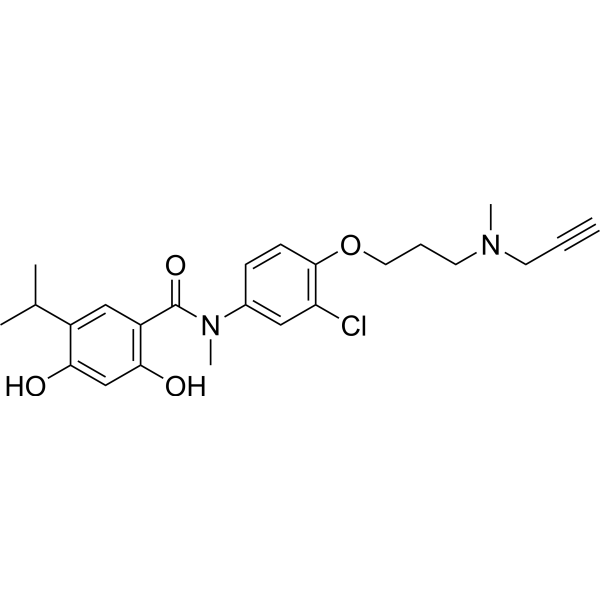
- HY-15735
-
|
|
c-Met/HGFR
|
Cancer
|
|
c-Met inhibitor 1 is an inhibitor of the c-Met receptor signaling pathway useful for the treatment of cancer including gastric, glioblastoma, and pancreatic cancer.
|
-

- HY-N0610A
-
|
3-Phenylacrylic acid; β-Phenylacrylic acid
|
|
|
|
Cinnamic acid has potential use in cancer intervention, with IC50s of 1-4.5 mM in glioblastoma, melanoma, prostate and lung carcinoma cells.
|
-
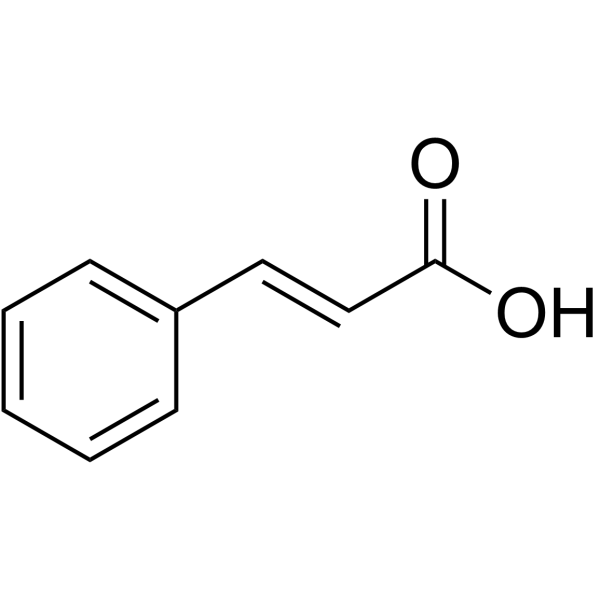
- HY-111651
-
-
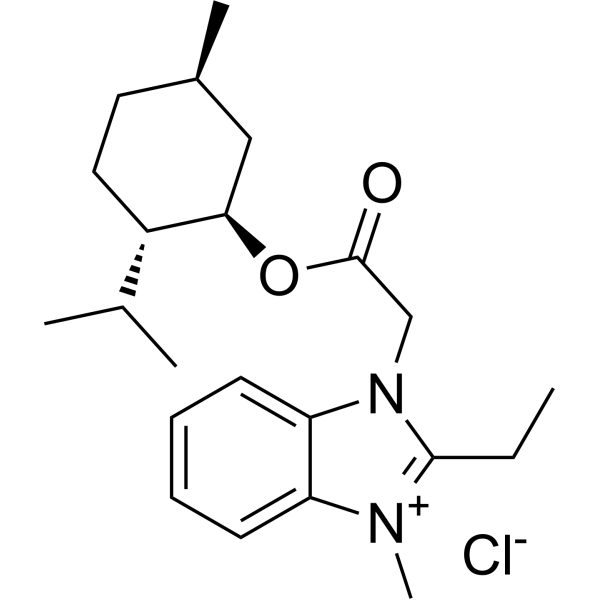
- HY-128685
-
|
Ac12Az9
|
P-glycoprotein
BCRP
|
Cancer
|
|
FD 12-9 is a flavonoid dimer, acts as a dual inhibitor of P-gp and BCRP, with EC50s of 285 nM and 0.9 nM, respectively. Anti-glioblastoma activity .
|
-
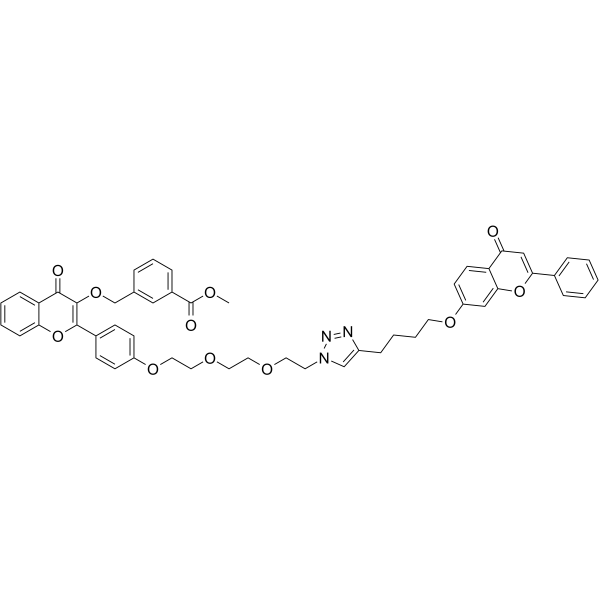
- HY-116165
-
|
|
Phospholipase
|
Cancer
|
|
ML298 is a potent and selective inhibitor of Phospholipase D2 (PLD2) with an IC50 of 355 nM. ML298 decreases invasive migration in U87-MG glioblastoma cells .
|
-
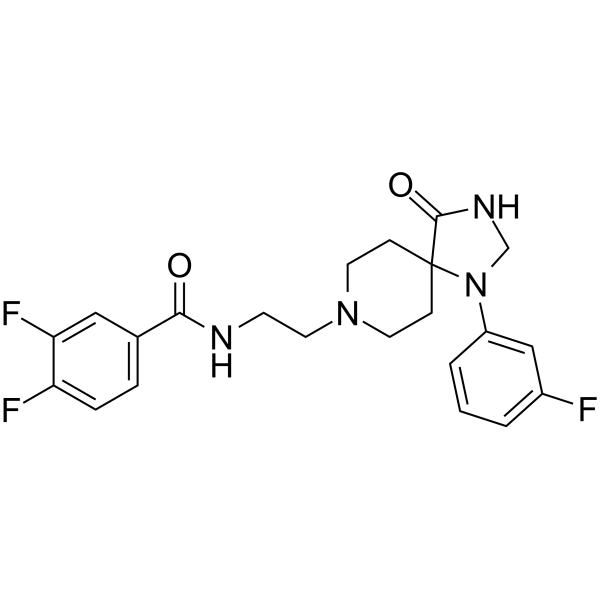
- HY-100475
-
|
|
|
|
|
KYP-2047 is a potent and BBB-penetrating prolyl-oligopeptidase (POP) inhibitor, with an Ki value of 0.023 nM. KYP-2047 reduces glioblastoma proliferation through angiogenesis and apoptosis modulation .
|
-
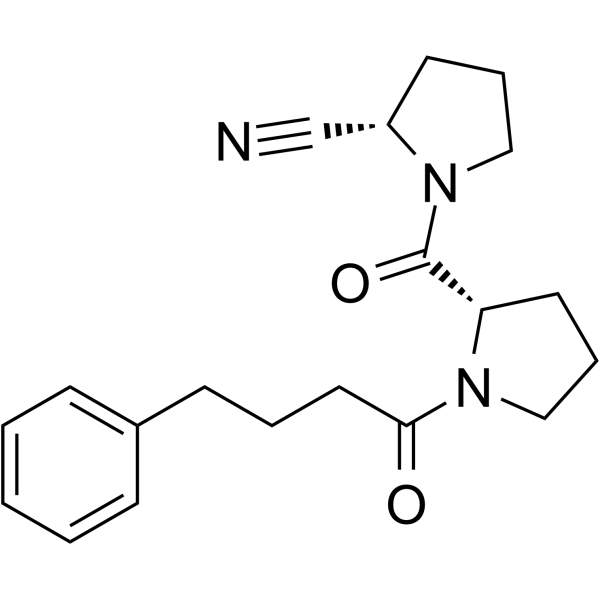
- HY-N0610AS
-
|
3-Phenylacrylic acid-d6; β-Phenylacrylic acid-d6
|
Endogenous Metabolite
|
Cancer
|
|
Cinnamic acid-d6 is the deuterium labeled Cinnamic acid. Cinnamic acid has potential use in cancer intervention, with IC50s of 1-4.5 mM in glioblastoma, melanoma, prostate and lung carcinoma cells.
|
-

- HY-N3001
-
|
|
VEGFR
Bcl-2 Family
Survivin
IAP
|
Cancer
|
|
Isolinderalactone suppresses human glioblastoma growth and angiogenic activity through the inhibition of VEGFR2 activation in endothelial cells . Isolinderalactone suppresses the expression of B-cell lymphoma 2 (Bcl-2), survi
|
-
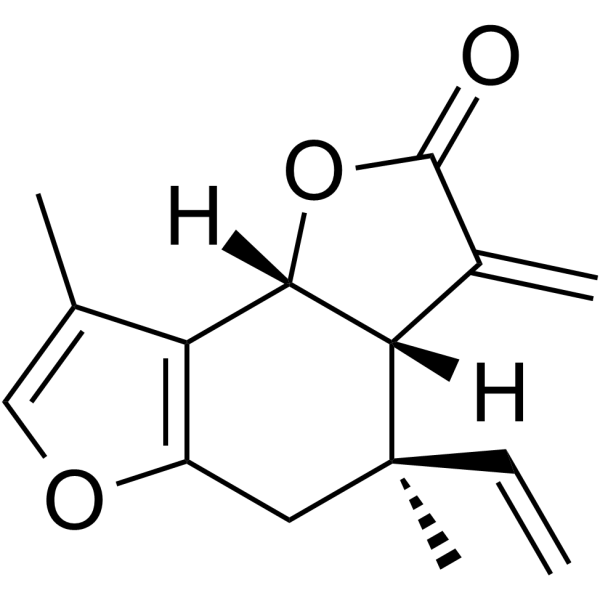
- HY-13703A
-
|
ACNU
|
DNA/RNA Synthesis
DNA Alkylator/Crosslinker
Apoptosis
|
Cancer
|
|
Nimustine hydrochloride (ACNU) is a DNA cross-linking and DNA alkylating agent, which induces DNA replication blocking lesions and DNA double-strand breaks and inhibits DNA synthesis, commonly used in chemotherapy for glioblastomas .
|
-
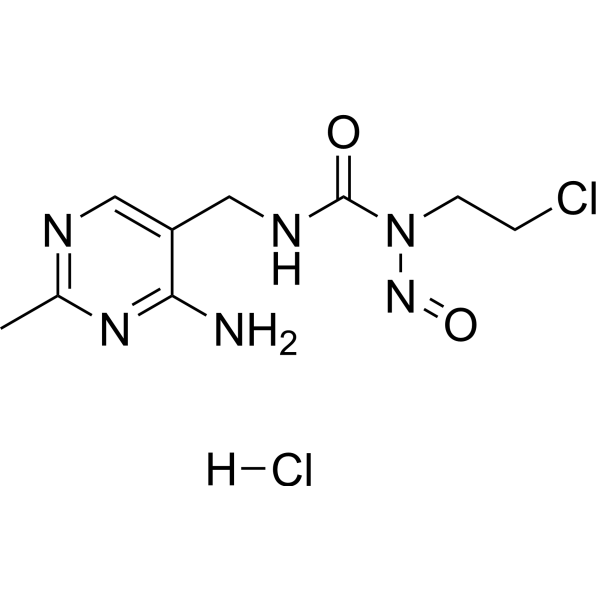
- HY-116273
-
|
|
Phospholipase
|
Cancer
|
|
ML299 is a selective allosteric modulator and a dual inhibitor of phospholipases D1 and D2 (IC50 values are 6 and 12 nM, respectively). ML299 decreases invasive migration in U87-MG glioblastoma cells .
|
-

- HY-149530
-
|
|
EGFR
Apoptosis
|
Cancer
|
|
EGFR-IN-86 (compound 4i) is an EGFR inhibitor (IC50: 1.5 nM) with high activity against glioblastoma. EGFR-IN-86 induces apoptosis and arrests the U87 cell cycle in the G2/M phase .
|
-
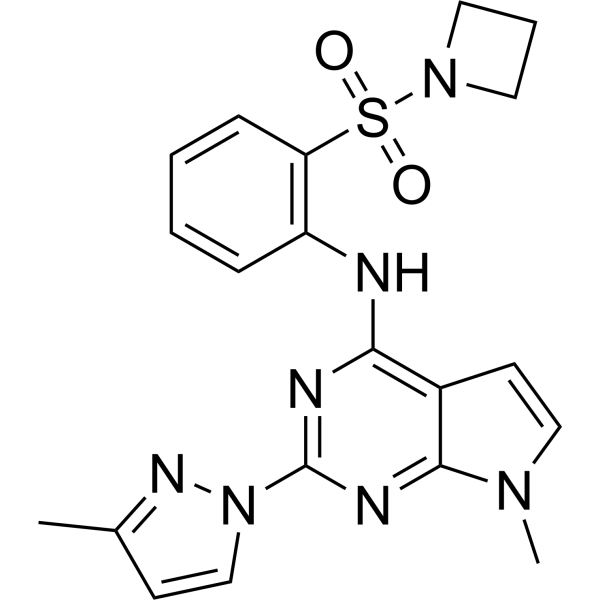
- HY-P99768
-
|
TTAC-0001
|
VEGFR
|
Cancer
|
|
Olinvacimab (TTAC-0001) is a fully human anti-VEGFR2 monoclonal antibody. Olinvacimab inhibits VEGF binds to KDR with a Kd value of 0.23 nM. Olinvacimab has antiangiogenic activity. Olinvacimab can be used for the research of recurrent glioblastoma and breast cancer .
|
-
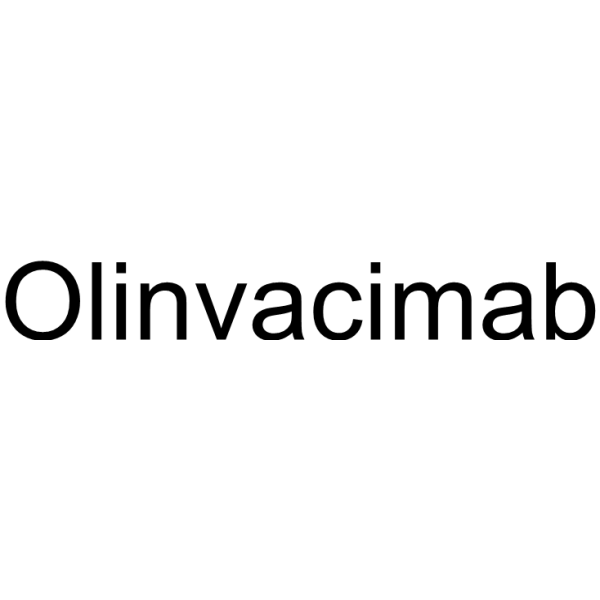
- HY-126771
-
|
Chr-A
|
Antibiotic
Bacterial
Akt
GSK-3
β-catenin
c-Myc
|
Infection
Cancer
|
|
Chrysomycin A (Chr-A), an antibiotic, can be obtained from Streptomyces. Chrysomycin A exhibits antitumor and anti-tuberculous and MRSA activities. As for glioblastoma, Chrysomycin A inhibits the proliferation, migration, and invasion of cancer cells through the Akt/GSK-3β/β-catenin signaling pathway .
|
-
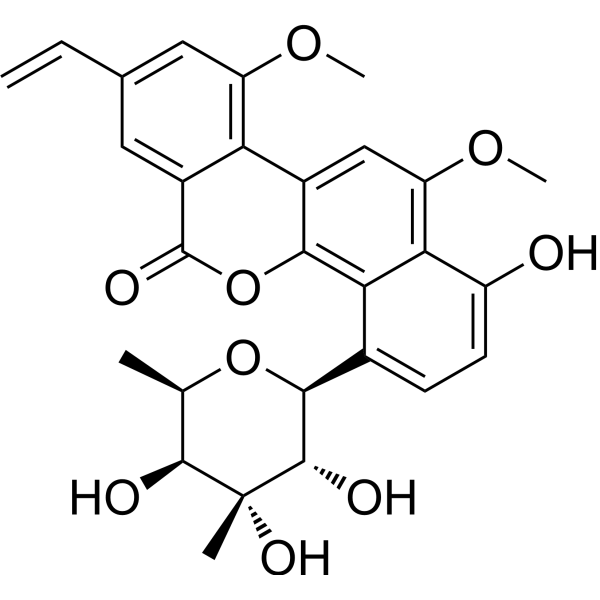
- HY-14590
-
-
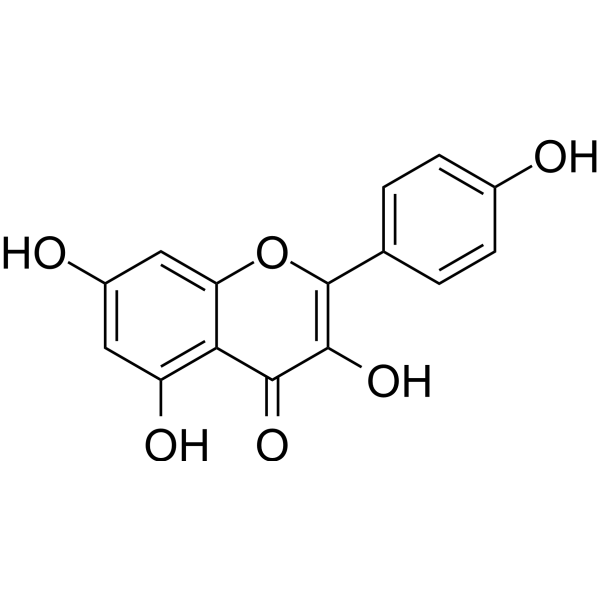
- HY-14942
-
|
RTA 744 free base; WP 744 free base; WP 769
|
Others
|
Cancer
|
|
Berubicin (RTA 744 free base; WP 744) is a 4'-O-benzyldoxorubicin that inhibits P-gp and MRP1-mediated efflux and has anticancer activity. Berubicin inhibits glioblastoma multiforme (GBM) and exhibits cytotoxicity. Berubicin has poor bioavailability in mice .
|
-
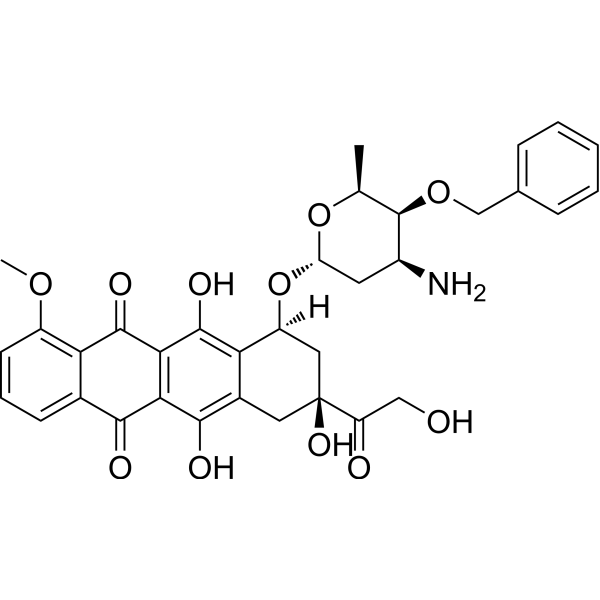
- HY-111452
-
|
|
EGFR
|
Cancer
|
|
EGFR-IN-85 (Compound 1) is an EGFR inhibitor. EGFR-IN-85 has IC50 value of 0.19 μM for EGFRvⅢ phosphorylation. EGFR-IN-85 can suppress EGFR signaling within tumors. EGFR-IN-85 can be used for Glioblastoma (GBM) research .
|
-
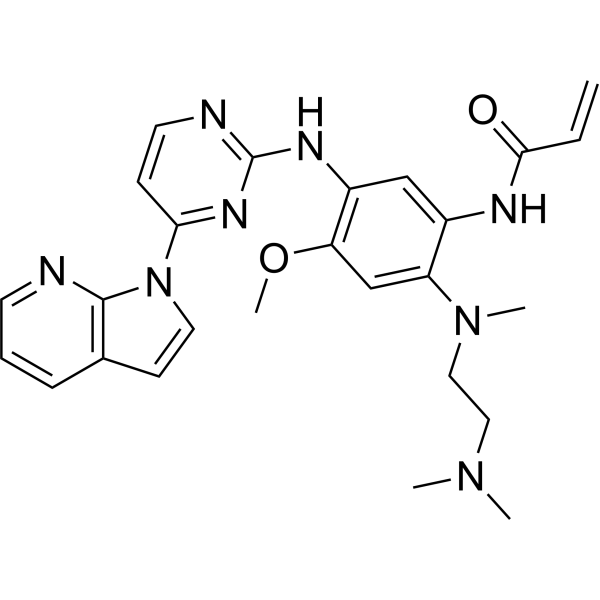
- HY-12456
-
|
|
Antibiotic
ADC Cytotoxin
DNA Alkylator/Crosslinker
Necroptosis
Apoptosis
|
Cancer
|
|
Duocarmycin SA is an orally active antitumor antibiotic with an IC50 of 10 pM . Duocarmycin SA is an extremely potent cytotoxic agent capable of inducing a sequence-selective alkylation of duplex DNA. Duocarmycin SA demonstrates synergistic cytotoxicity against glioblastoma multiforme (GBM) cells treated with proton radiation in vitro .
|
-
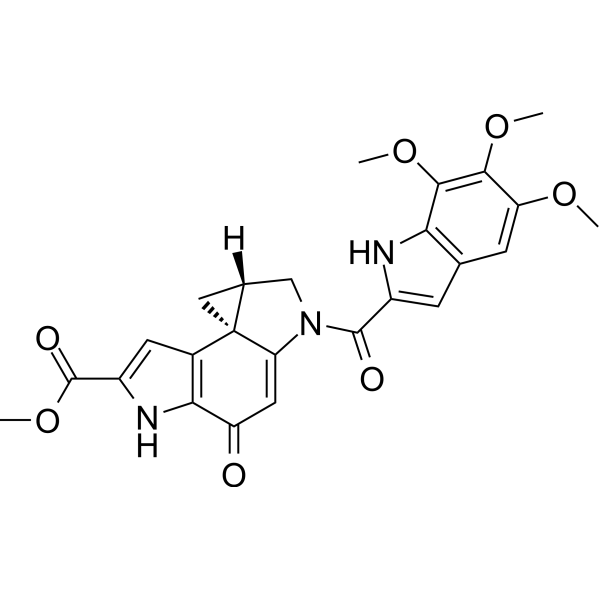
- HY-N0610AS2
-
|
3-Phenylacrylic acid-13C3; β-Phenylacrylic acid-13C3
|
Isotope-Labeled Compounds
Endogenous Metabolite
|
Cancer
|
|
Cinnamic acid- 13C3 (3-Phenylacrylic acid- 13C3) is the 13C labeled Cinnamic acid (HY-N0610A). Cinnamic acid has potential use in cancer intervention, with IC50s of 1-4.5 mM in glioblastoma, melanoma, prostate and lung carcinoma cells .
|
-

- HY-111187
-
|
KX-02
|
Src
Microtubule/Tubulin
Apoptosis
|
Cancer
|
|
KX2-361 (KX-02) is a Src-kinase and tubulin polymerization inhibitor. KX2-361 shows good oral bioavailability and readily crosses the BBB in mice. KX2-361 shows anti-tumor activity and induces apoptosis of Glioblastoma (GBM) cell .
|
-
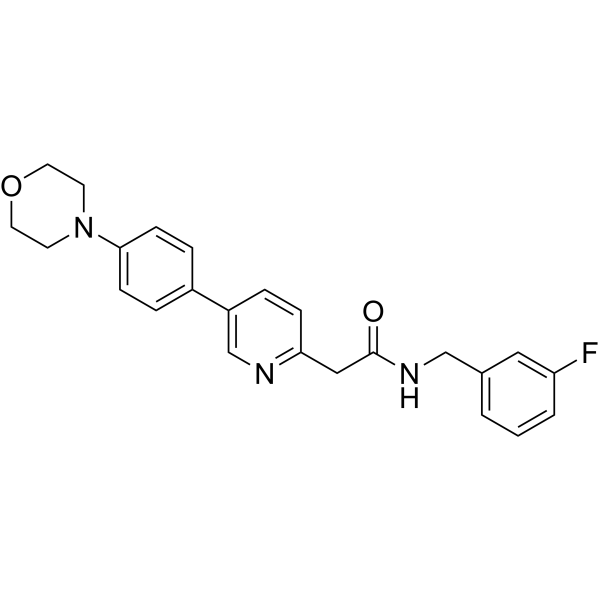
- HY-N2599
-
|
|
COX
Apoptosis
|
Cancer
|
|
Taraxerol acetate is a COX-1 and COX-2 inhibitor with IC50 values of 116.3 μM and 94.7 μM, respectively. Taraxerol acetate the has the anticancer potential and induces cell apoptosis .
|
-
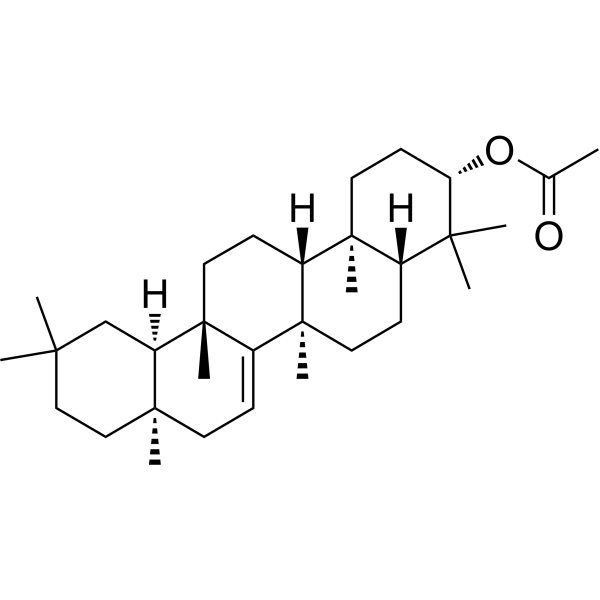
- HY-P2271
-
|
|
Apelin Receptor (APJ)
|
Cancer
|
|
MM 54 (compound 5) is a competitive antagonist at APJ, with an IC50 of 93 nM. MM 54 behaves as a potent and selective inhibitor of apelin binding and APLNR activation .
|
-
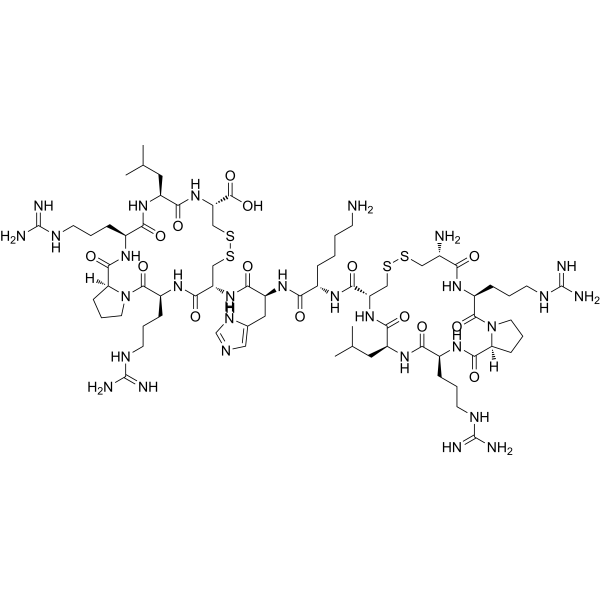
- HY-149375
-
|
|
Microtubule/Tubulin
|
Cancer
|
|
Tubulin inhibitor 37 (Compound 12) is a Tubulin inhibitor that can effectively inhibit Tubulin aggregation (IC50=1.3 µM). Tubulin inhibitor 37 exhibits antiproliferative activity against human tumor cell lines and has potential for studying cancer .
|
-

- HY-120864
-
|
|
Wnt
|
Cancer
|
|
SEN461 is a potent and orally active Wnt pathway inhibitor. SEN461 shows effective anti-tumor activity and can be used for GBM research .
|
-

- HY-B0380A
-
|
|
Oct3/4
ERK
Akt
Apoptosis
|
Metabolic Disease
Cancer
|
|
Trimebutine maleate is an orally anti-tumor agent. Trimebutine maleate selectively suppresses stemness and proliferation of ovarian cancer stem cells (CSCs). Trimebutine maleate reduces the colonic muscle hypercontractility, modulates gastrointestinal motility, induces apoptosis and can be used for the research of glioma/glioblastoma and irritable bowel syndrome .
|
-

- HY-W040150
-
|
|
LXR
|
Neurological Disease
Inflammation/Immunology
Cancer
|
|
24S,25-Epoxycholesterol is an agonist for Liver X Receptor (LXR). 24S,25-Epoxycholesterol exhibits properties in regulating the cholesterol efflux , inhibiting tumor growth against gastric cancer and glioblastoma and inducing apoptosis in BMMC cells .
|
-

- HY-103407A
-
|
|
Dopamine Receptor
|
Neurological Disease
Cancer
|
|
PD 168568 dihydrochloride is a orally active and potent dopamine receptor D4 (DRD4) antagonist. PD 168568 dihydrochloride contains an isoindolinone and is selective for the D4 receptor versus D2 and D3, with Ki values of 8.8, 1842, and 2682 nM, respectively. PD 168568 dihydrochloride can be used for glioblastoma (GBM) research .
|
-
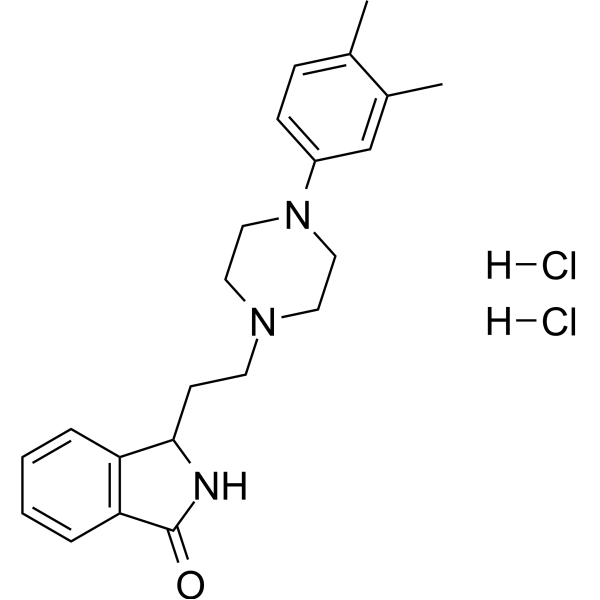
- HY-126244
-
|
|
CDK
|
Cancer
|
|
CDK4/6-IN-3 is a brain-penetrant CDK4/CDK6 inhibitor with Kis of <0.3 nM and 2.2 nM, respectively. CDK4/6-IN-3 inhibits CDK1 with a Ki of 110 nM. CDK4/6-IN-3 can be used for the treatment of glioblastoma .
|
-

- HY-14590R
-
|
Kempferol(Standard); Robigenin (Standard)
|
Estrogen Receptor/ERR
Autophagy
Mitophagy
Apoptosis
HIV
Parasite
Endogenous Metabolite
|
Cancer
|
|
Kaempferol (Standard) is the analytical standard of Kaempferol. This product is intended for research and analytical applications. Kaempferol (Kempferol), a flavonoid found in many edible plants, inhibits estrogen receptor α expression in breast cancer cells and induces apoptosis in glioblastoma cells and lung cancer cells by activation of MEK-MAPK. Kaempferol can be uesd for the research of breast cancer .
|
-
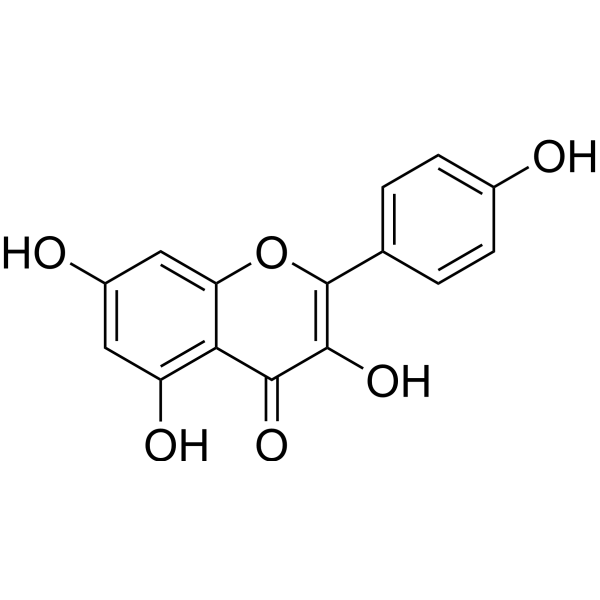
- HY-126147
-
|
|
HDAC
|
Cancer
|
|
J22352 is a PROTAC (proteolysis-targeting chimeras)-like and highly selective HDAC6 inhibitor with an IC50 value of 4.7 nM. J22352 promotes HDAC6 degradation and induces anticancer effects by inhibiting autophagy and eliciting the antitumor immune response in glioblastoma cancers, and leading to the restoration of host antitumor activity by reducing the immunosuppressive activity of PD-L1 .
|
-
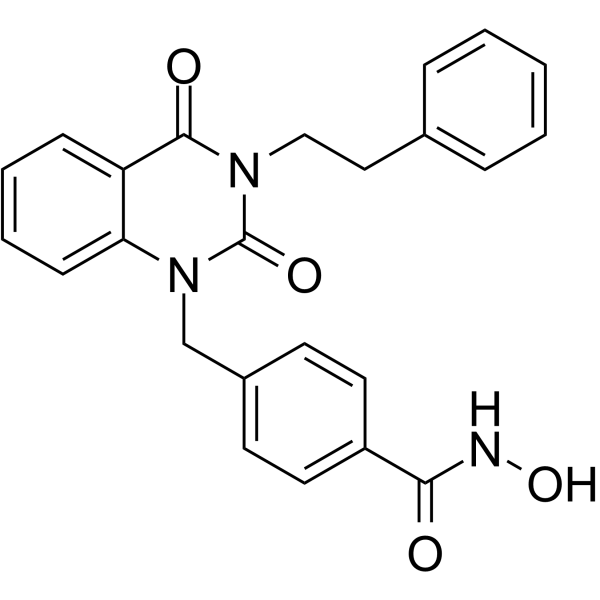
- HY-W016645
-
|
|
Aldehyde Dehydrogenase (ALDH)
|
Cancer
|
|
4-Diethylaminobenzaldehyde is a reversible aldehyde dehydrogenases (ALDHs) inhibitor, with a Ki of 4 nM for ALDH1. 4-Diethylaminobenzaldehyde displays potent anti-androgenic effect (IC50= 1.71μM) .
|
-
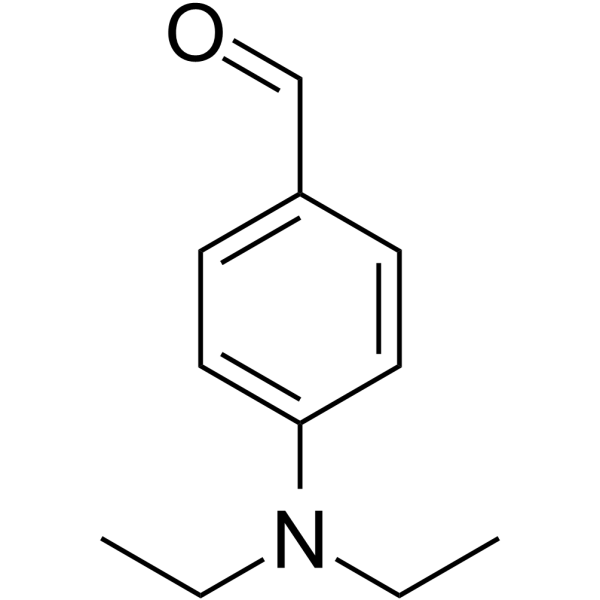
- HY-N9341
-
|
|
Autophagy
|
Cancer
|
|
Norswertianin, a xanthone compound, serves as a powerful anti-glioma compound. Norswertianin induces GBM cells differentiation through oxidative stress and Akt/mTOR dependent autophagy .
|
-
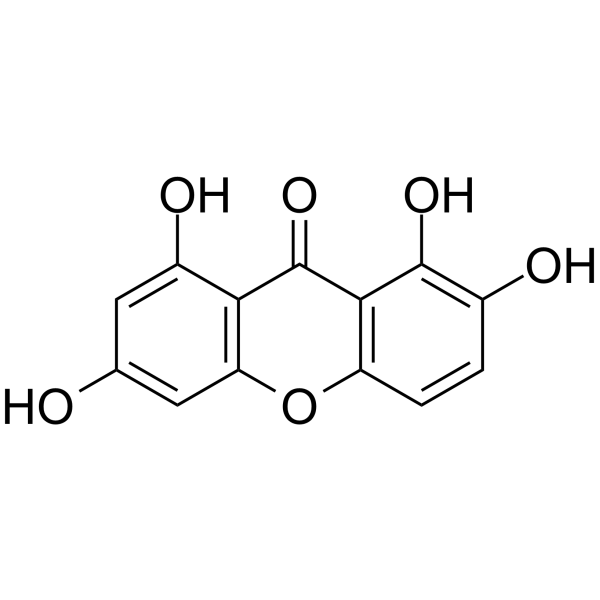
- HY-151350
-
-
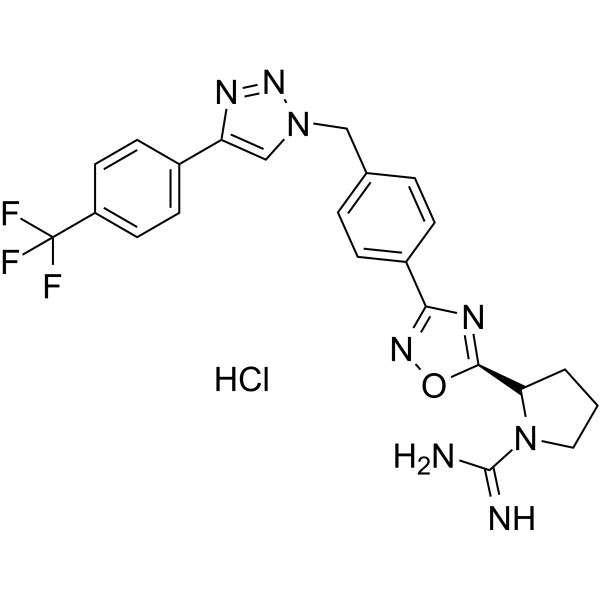
- HY-B0688S
-
|
4,4′-Diaminodiphenyl sulfone-d8; DDS-d8
|
Antibiotic
Parasite
Bacterial
Reactive Oxygen Species
|
Infection
Inflammation/Immunology
Cancer
|
|
Dapsone-d8 is a deuterium labeled Dapsone. Dapsone is an orally active and blood-brain penetrant sulfonamide antibiotic with antibacterial, antigenic and anti-inflammatory activities[1]. Dapsone exerts effective antileprosy activity and inhibits folate synthesis in cell extracts of M. leprae. Dapsone can be used as an anticonvulsant and also in the research of skin and glioblastoma diseases[2][3][4][5].
|
-

- HY-P99445
-
|
APG101; CAN008
|
TNF Receptor
|
Inflammation/Immunology
Cancer
|
|
Asunercept (APG101; CAN008) is a soluble CD95-Fc fusion protein targeting CD95L. Asunercept disrupts CD95/CD95L signaling by selectively binding to CD95L. Asunercept can be used in the research of glioblastoma multiforme (GBM), myelodysplastic syndrome (MDS), and graft-versus-host disease (GvHD) .
|
-
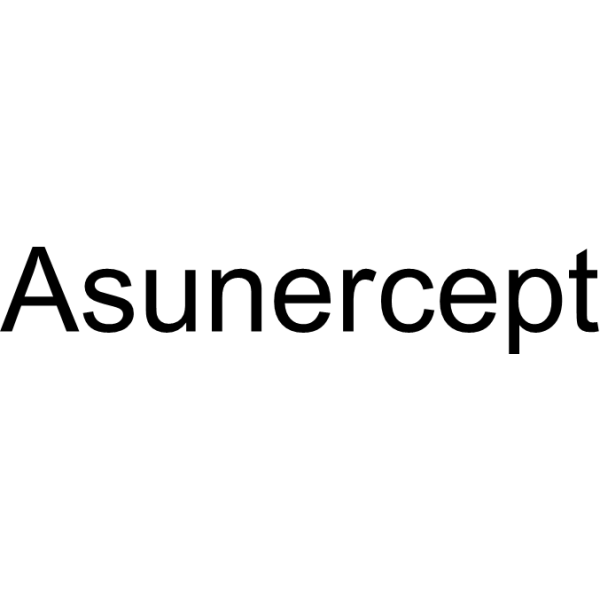
- HY-10261B
-
|
(E/Z)-BIBW 2992
|
|
|
|
(E/Z)-Afatinib ((E/Z)-BIBW 2992) is the mixture of (E)-Afatinib and (Z)-Afatinib. Afatinib (HY-10261) is an irreversible inhibitor of EGFR, by irreversibly binding to their ATP binding site to block activation of EGFR, HER2, HER4, and EGFRvIII. Afatinib used in co-administration with Temozolomide (HY-17364), potently targeting to EGFRvIII-cMet signaling in glioblastoma cells .
|
-

- HY-115567
-
|
1-(β-D-2-Deoxyribofuranosyl)-5-nitroindole
|
Apoptosis
|
Cancer
|
|
5-NIdR (1-(β-D-2-Deoxyribofuranosyl)-5-nitroindole), an artificial nucleoside, exhibits the ability to inhibit the replication of DNA lesions generated by Temozolomide (HY-17364). 5-NIdR induces cancer cells apoptosis and arrests cell cycle at G0 phase. 5-NIdR enhances Temozolomide anti-tumor efficacy in murine glioblastoma model .
|
-
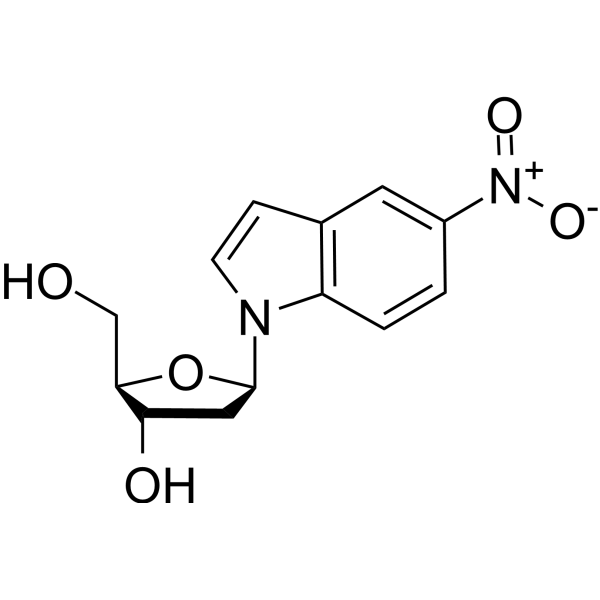
- HY-N6253
-
|
(+)-Pinoresinol
|
Apoptosis
|
Cancer
|
|
Pinoresinol is a lignol of plant origin serving for defense in a caterpillar. Pinoresinol drastically sensitizes cancer cells against TNF-related apoptosis-inducing ligand (TRAIL) -induced apoptosis .
|
-
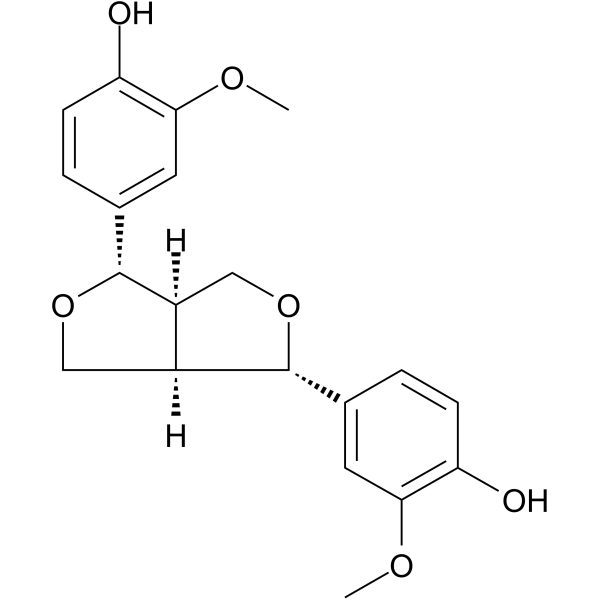
- HY-156019
-
|
|
FGFR
|
Cancer
|
|
FGFR1 inhibitor-10 (Compound 4i) is an FGFR1 inhibitor (IC50: 28 nM). FGFR1 inhibitor-10 inhibits the phosphorylation of FGFR1. FGFR1 inhibitor-10 has anti-angiogenic, anti-invasion activity, and anti-tumor effect .
|
-
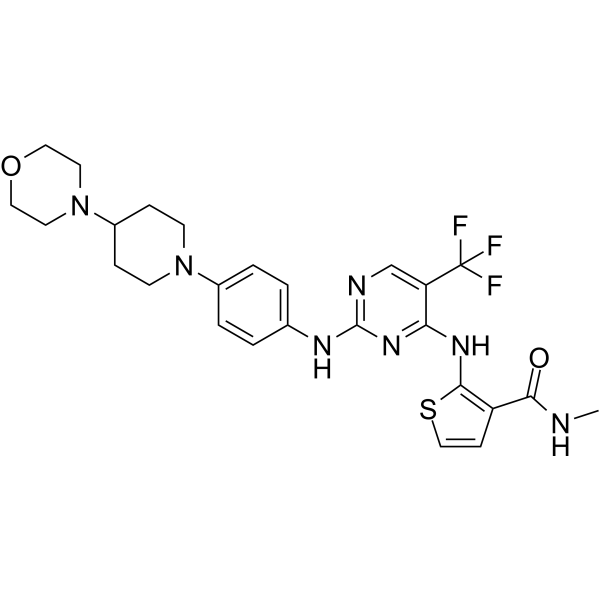
- HY-163290
-
|
|
Fluorescent Dye
Monoamine Oxidase
|
Cancer
|
|
HDAC-MB a probe that is activated by HDAC6 and can detect and eliminate glioma cells through activation by HDAC6. HDAC-MB reveals antimetastatic and antiproliferative properties, inhibits glioma invasion and induces cellular apoptosis .
|
-
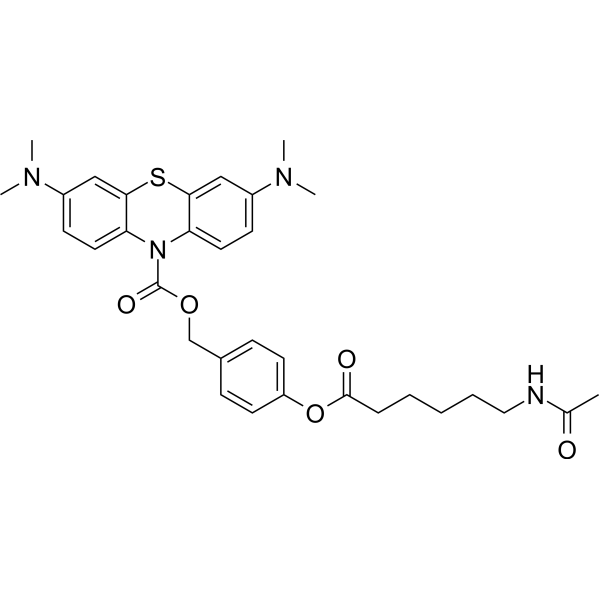
- HY-149696
-
|
|
NF-κB
|
Cancer
|
|
IR-Crizotinib is a NF-κB-inducing kinase (NIK) inhibitor that crosses the blood-brain barrier and fluorescently localizes intracranial glioblastoma (GBM) in mice (IC50=3.381 μM). IR-Crizotinib is conjugated from the near-infrared dye IR-786 and the NF-κB-inducing kinase (NIK) inhibitor Crizotinib. IR-Crizotinib can effectively inhibit the growth and invasion of glioma in vitro and in vivo and can be used in cancer research .
|
-

- HY-155458
-
|
|
PARP
|
Inflammation/Immunology
Cancer
|
|
HYDAMTIQ is a PARP-1/2 inhibitor (IC50: 29-38 nM) with anticancer, anti-inflammatory, and ischemic protective effects. HYDAMTIQ inhibits pulmonary PARP activity, is effective against allergen-induced cough and dyspnea, and inhibits bronchial hyperresponsiveness to methacholine. HYDAMTIQ has broad-spectrum tumor suppressor effects, including ovarian and breast cancers, prostate and pancreatic tumors, and glioblastoma multiforme. HYDAMTIQ has demonstrated in vivo efficacy in animal models of cerebral ischemia, asthma, cancer, and more .
|
-
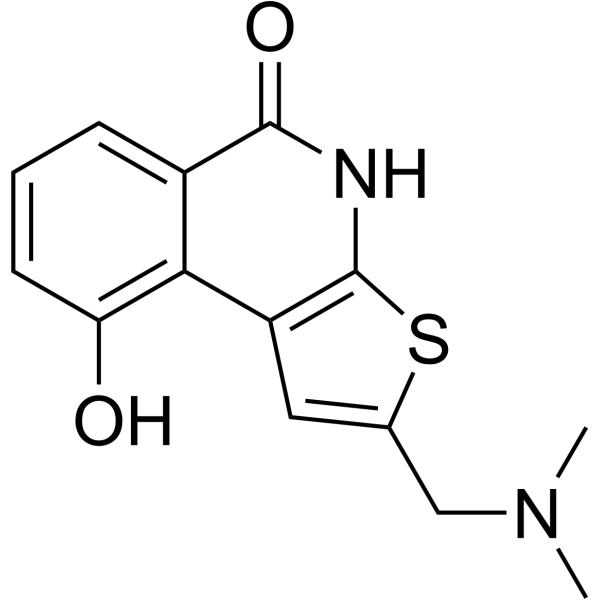
- HY-162090
-
|
|
TRP Channel
|
Cancer
|
|
TRPC antagonist 1 (compound 15g) is a potent TRP channel (TRPC) antagonist with IC50s of 2.4 μM, 12.2 μM, 7.6 μM, 2.9 μM, and 3.4 μM for TRPC3, TRPC4, TRPC5, TPRC6, and TRPC7, respectively. TRPC antagonist 1 displays noteworthy anti-glioblastoma efficacy in vitro against U87 cell lines .
|
-
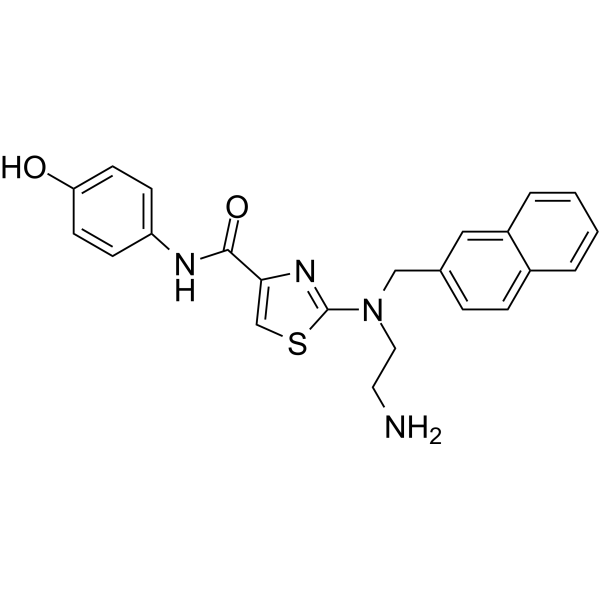
- HY-161155
-
|
|
HDAC
|
Inflammation/Immunology
|
|
HDAC6-IN-31 (compound 8m) is a selective HDAC6 inhibitor, with the IC50 value of 0.026 μM, that significantly inhibits the production and release of pro-inflammatory cytokines. While HDAC6 is critically involved in the activation of inflammasomes, HDAC6-IN-31 has the potential to inhibit NLRP3 inflammasome-driven inflammatory diseases. HDAC6-IN-31 also inhibits glioblastoma cell migration .
|
-
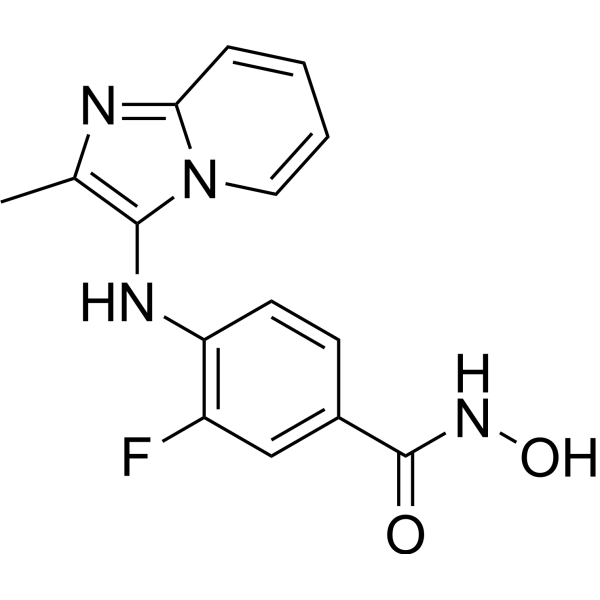
- HY-115925
-
|
|
SHP2
Phosphatase
|
Cancer
|
|
SHP2-IN-9 is a specific SHP2 inhibitor (IC50 =1.174 μM) with enhanced blood–brain barrier penetration. SHP2-IN-9 shows 85-fold more selective for SHP2 than SHP1. SHP2-IN-9 inhibits SHP2-mediated cell signal transduction and cancer cell proliferation, and inhibits the growth of cervix cancer tumors and glioblastoma growth in vivo .
|
-

- HY-115630
-
|
|
RIP kinase
Caspase
Apoptosis
|
Cancer
|
|
cRIPGBM chloride, an orally active, proapoptotic derivative. cRIPGBM can be generated from glioblastoma multiforme (GBM) cancer stem cells (CSCs). cRIPGBM(chloride) targets to receptor-interacting protein kinase 2 (RIPK2) to induce caspase 1-dependent apoptosis. cRIPGBM(chloride) suppresses the formation of RIPK2/TAK1 (prosurvival complex), and increases the formation of RIPK2/caspase 1 (proapoptotic complex). cRIPGBM(chloride) exerts potent anti-tumor activity in vivo in animal models .
|
-
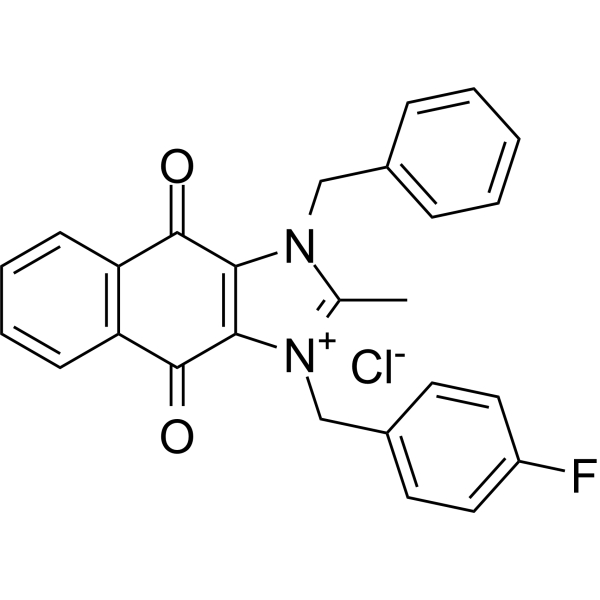
- HY-131003A
-
|
DS-6051b free base; AB-106 free base; IBI-344 free base
|
ROS Kinase
|
Cancer
|
|
Taletrectinib (DS-6051b) free base is a potent, orally active, and next-generation selective ROS1/NTRK inhibitor. Taletrectinib free base potently inhibits recombinant ROS1, NTRK1, NTRK2, and NTRK3 with IC50s of 0.207, 0.622, 2.28, and 0.98 nM, respectively. Taletrectinib free base also inhibits ROS1 G2032R and other Crizotinib-resistant ROS1 mutants .
|
-

- HY-131003
-
|
DS-6051b; AB-106; IBI-344
|
ROS Kinase
|
Cancer
|
|
Taletrectinib (DS-6051b) is a potent, orally active, and next-generation selective ROS1/NTRK inhibitor. Taletrectinib potently inhibits recombinant ROS1, NTRK1, NTRK2, and NTRK3 with IC50s of 0.207, 0.622, 2.28, and 0.98 nM, respectively. Taletrectinib also inhibits ROS1 G2032R and other Crizotinib-resistant ROS1 mutants .
|
-
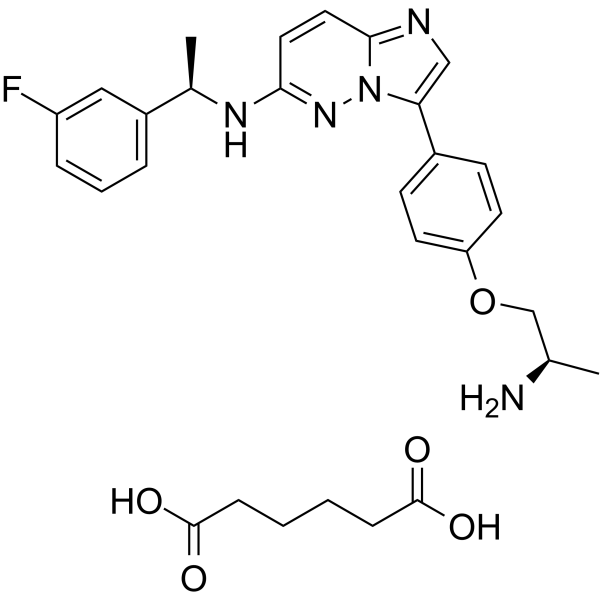
- HY-16532
-
|
AEZS-108; AN-152
|
GnRH Receptor
|
Cancer
|
|
Zoptarelin doxorubicin (AEZS-108; AN-152) is a hybrid anticancer agent, containing Zoptarelin and Doxorubicin. Zoptarelin doxorubicin has been used to research targeting tumors expressing LHRH receptors. Zoptarelin doxorubicin abolishes tumor progression and induces remarkable apoptosis in vitro .
|
-
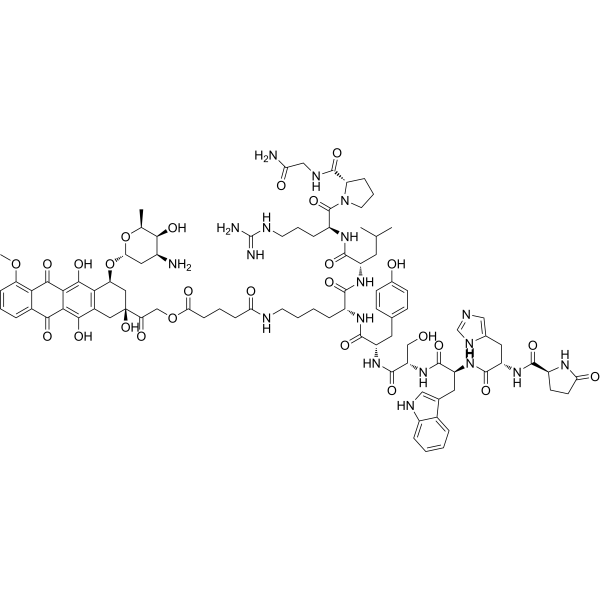
- HY-P5557
-
|
|
Bacterial
Necroptosis
|
Cancer
|
|
TP4 (Nile tilapia piscidin) is an orally active piscidin-like antimicrobial peptide. TP4 inhibits multiple gram positive and negative strains (MIC: 0.03-10 μg/mL). TP4 shows hemolytic activities. TP4 enhances immune response, antioxidant activity, and intestinal health against bacterial infections. TP4 also has anti-tumor effect, and induces necrosis by triggering mitochondrial dysfunction in cancer cells .
|
-

- HY-157168
-
|
|
Trk Receptor
|
Neurological Disease
|
|
TrkA-IN-6 (compound R48) is a hydrazone-like, selective inhibitor of tropomyosin kinase type A receptor kinase (TrkA). TrkA-IN-6 exhibited a higher cytotoxic effect on U87 GBM cells than Temozolomide (HY-17364), with an IC50 of 68.99 μM .
|
-

- HY-16141
-
Cilengitide
Maximum Cited Publications
38 Publications Verification
EMD 121974
|
Integrin
Autophagy
Apoptosis
STAT
PD-1/PD-L1
|
Cancer
|
|
Cilengitide (EMD 121974) is a potent integrins antagonist with IC50s of 0.61 nM (ανβ3), 8.4 nM (ανβ5) and 14.9 nM (α5β1), respectively. Cilengitide inhibits the binding of ανβ3 and ανβ5 to Vitronectin with IC50s of 4 nM and 79 nM, respectively. Cilengitide inhibits TGF-β/Smad signaling, mediates PD-L1 expression. Cilengitide also induces apoptosis, shows antiangiogenic effect in the research against glioblastoma and other cancers .
|
-

- HY-148833
-
|
|
MDM-2/p53
|
Cancer
|
|
MDM2-p53-IN-16 is a MDM2-p53 complex inhibitor with an IC50 value of 4.3 nM to dissociate human p53/MDM2 complex. MDM2-p53-IN-16 reactivates p53, and induces Glioblastoma Multiforme (GBM) cell apoptosis and cell-cycle arrest. MDM2-p53-IN-16 can be used for the cancer research .
|
-
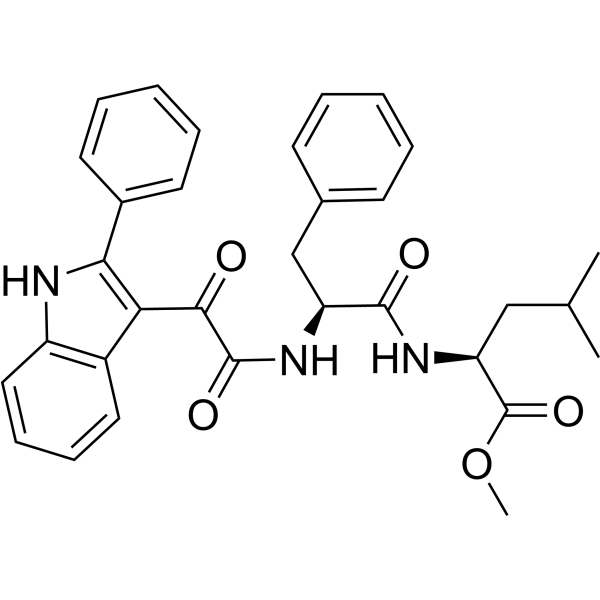
- HY-10985
-
|
Salinosporamide A; NPI-0052
|
Proteasome
|
Cancer
|
|
Marizomib (Salinosporamide A) is a second-generation, irreversible, brain-penetrant, pan-proteasome inhibitor. Marizomib inhibits the CT-L (β5), CT-T-laspase-like (C-L, β1) and trypsin-like (T-L, β2) activities of the 20S proteasome (IC50=3.5, 28, and 430 nM, respectively) .
|
-

- HY-146358
-
|
|
Microtubule/Tubulin
|
Cancer
|
|
Anticancer agent 49 (compound 69) is a broad spectrum anticancer agent. Anticancer agent 49 inhibits tubulin polymerization. Anticancer agent 49 shows antiproliferative activity. Anticancer agent 49 has the potential for the research of solid and hematological tumors .
|
-
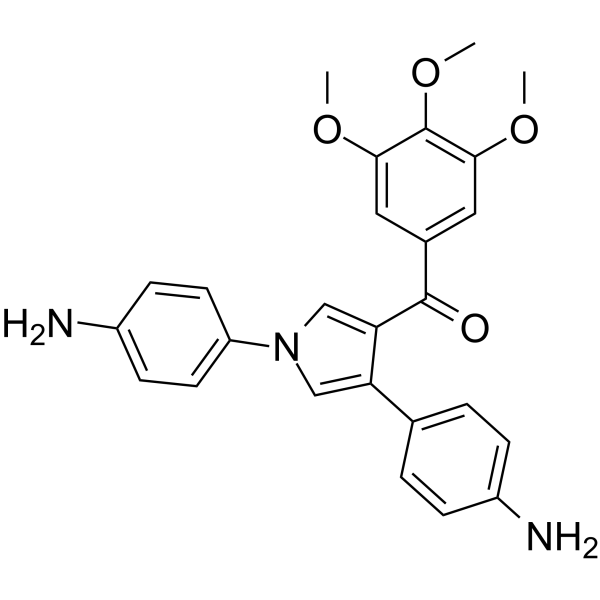
- HY-155888
-
|
|
Epigenetic Reader Domain
|
Cancer
|
|
IV-255 is a selective small molecule inhibitor of the BRG1 bromodomain. IV-255 increases the extent of DNA damage induced by Temozolomide (HY-17364) and Bleomycin (HY-108345). IV-255 inhibits the invasiveness of GBM cells. IV-255 enhances Temozolomide-induced cell death and the apoptosis-inducing activity of Temozolomide .
|
-

- HY-155889
-
|
|
Epigenetic Reader Domain
|
Cancer
|
|
IV-275 is an inhibitor of both BRG1 and BRM bromodomains. IV-275 increases the extent of DNA damage induced by Temozolomide (HY-17364) and Bleomycin (HY-108345). IV-275 inhibits the invasiveness of GBM cells. IV-275 enhances Temozolomide-induced cell death and the apoptosis-inducing activity of Temozolomide .
|
-
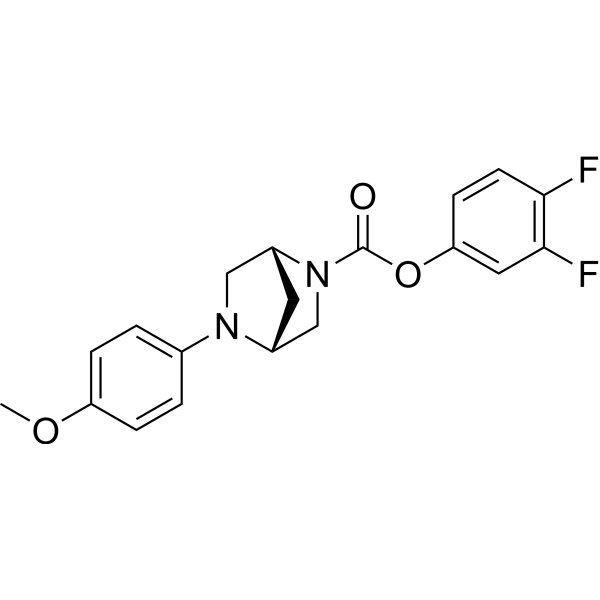
- HY-145931
-
|
|
mTOR
Autophagy
|
Cancer
|
|
CC214-2 is an oral active and selective mTOR kinase inhibitor. CC214-2 targets to both of mTORC1 (pS6) and mTORC2 (pAktS473). CC214-2 induces autophagy, which is a potential target for host-directed therapy (HDT) in tuberculosis. CC214-2 exhibits synergistic bactericidal and sterilizing activity agasinst tuberculosis (TB), and shortens the treatment duration. CC214-2 also inhibits Rapamycin (HY-10219)-resistant signaling and the growth of glioblastomas in vitro and in vivo .
|
-
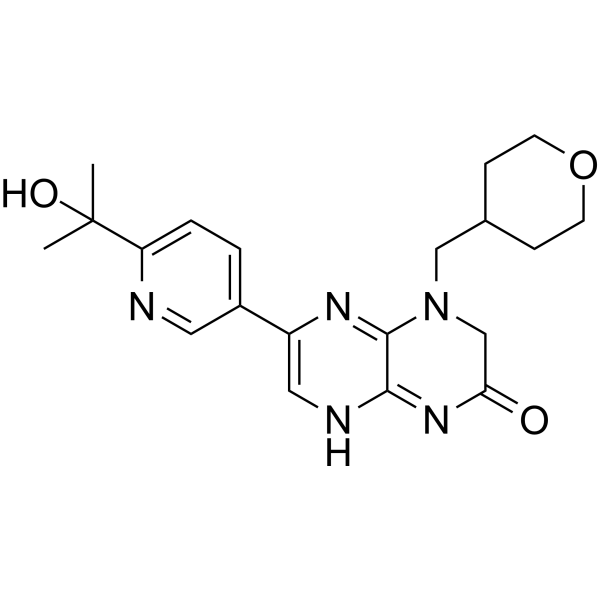
- HY-B1334A
-
|
|
Mitochondrial Metabolism
Apoptosis
|
Cardiovascular Disease
Cancer
|
|
Perhexiline maleate is an orally active CPT1 and CPT2 inhibitor that reduces fatty acid metabolism. Perhexiline maleate induces mitochondrial dysfunction and apoptosis in hepatic cells. Perhexiline maleate can cross the blood brain barrier (BBB) and shows anti-tumor activity. Perhexiline maleate can be used in the research of cancers, and cardiovascular disease like angina .
|
-

- HY-136484
-
|
|
FLAP
|
Cancer
|
|
FEN1-IN-3 (Compound 4) is a human flap endonuclease-1 (hFEN1) inhibitor. FEN1-IN-3 stabilizes hFEN1 with an EC50 of 6.8 μM .
|
-
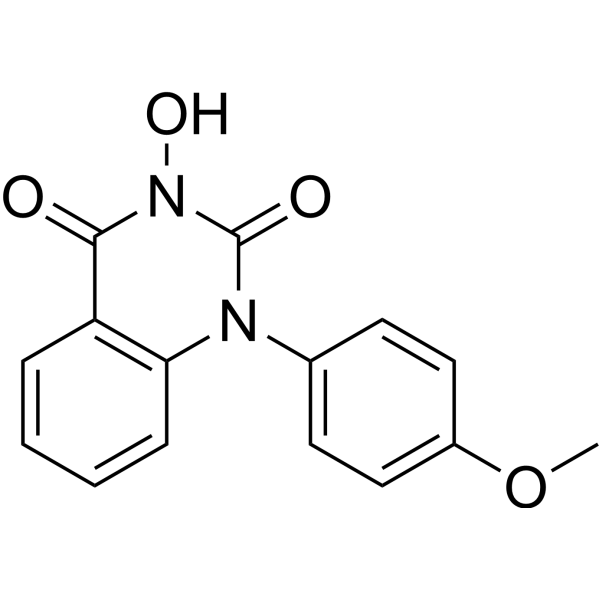
- HY-136485
-
|
|
FLAP
|
Cancer
|
|
FEN1-IN-4 (Compound 2) is a human flap endonuclease-1 (hFEN1) inhibitor .
|
-

- HY-146357
-
|
|
Microtubule/Tubulin
|
Cancer
|
|
Anticancer agent 48 (compound 48) is a broad spectrum anticancer agent. Anticancer agent 48 inhibits tubulin polymerization. Anticancer agent 48 shows antiproliferative activity. Anticancer agent 48 shows antitumor activity in vivo. Anticancer agent 48 has the potential for the research of solid and hematological tumors .
|
-
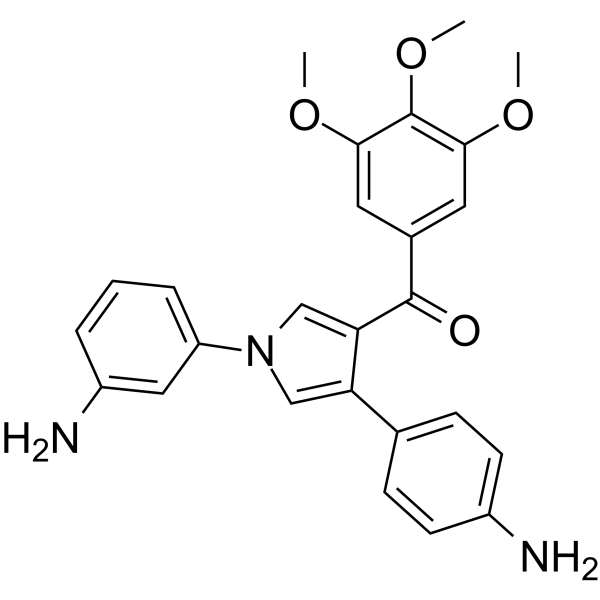
- HY-150791
-
|
|
Reactive Oxygen Species
DNA/RNA Synthesis
|
Cancer
|
|
FLDP-5 is a blood-brain barrier (BBB) penetrant curcuminoid analogues. FLDP-5 can induce production of ROS (Reactive Oxygen Species), DNA damage and cell cycle S phase arrest. FLDP-5 exhibits highly potent tumour-suppressive effects with anti-proliferative and anti-migratory activities on LN-18 cells .
|
-

- HY-150794
-
|
|
Others
|
Cancer
|
|
FLDP-8 is a curcuminoid analogues, has potent anti-cancer effects. FLDP-8 can induce cell death with an IC50 value of 4 μM in LN-18 cells .
|
-
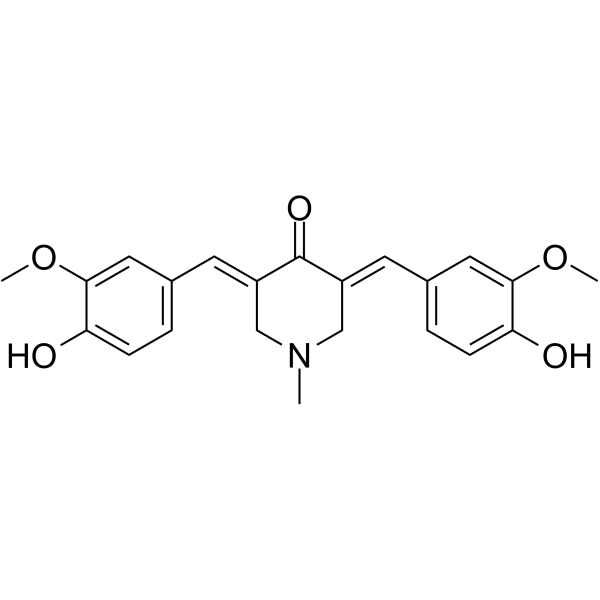
- HY-B1334
-
|
|
Mitochondrial Metabolism
Apoptosis
|
Cardiovascular Disease
Cancer
|
|
Perhexiline is an orally active CPT1 and CPT2 inhibitor that reduces fatty acid metabolism. Perhexiline induces mitochondrial dysfunction and apoptosis in hepatic cells. Perhexiline can cross the blood brain barrier (BBB) and shows anti-tumor activity. Perhexiline can be used in the research of cancers, and cardiovascular disease like angina .
|
-

- HY-151886
-
|
|
PROTACs
Indoleamine 2,3-Dioxygenase (IDO)
|
Neurological Disease
Cancer
|
|
NU223612 is a potent PROTAC (PROTACs) that degrades indoleamine 2,3-dioxygenase 1 (IDO1) (Indoleamine 2,3-Dioxygenase (IDO)) with a Kd of 640 nM. NU223612 potently degrades the IDO1 protein through CRBN-mediated proteasomal degradation. NU223612 is bound to CRBN with an affinity of 290 nM. NU223612 can cross the blood-brain barrier (BBB) .
|
-

- HY-117357
-
|
|
SGK
|
Cancer
|
|
SI-113 is a SGK1 inhibitor, with an IC50 of 600 nM. SI113 induces autophagy .
|
-

- HY-138684
-
-
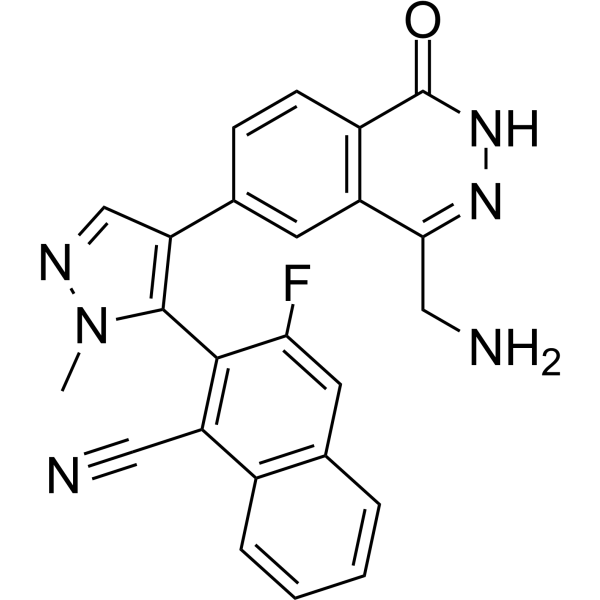
- HY-138684A
-
-

- HY-146375
-
|
|
Ephrin Receptor
|
Cancer
|
|
UniPR505 (Compound 14) is an EphA2 antagonist with an IC50 of 0.95 µM. UniPR505 displays anti-angiogenic properties .
|
-
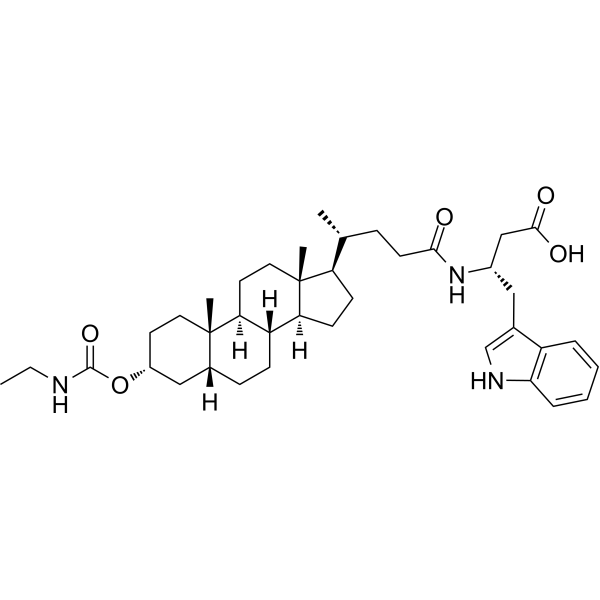
- HY-103693
-
NAZ2329
1 Publications Verification
|
Phosphatase
|
Cancer
|
|
NAZ2329, the first cell-permeable inhibitor of R5 subfamily of receptor-type protein tyrosine phosphatases (RPTPs), allosterically and preferentially inhibits PTPRZ (IC50=7.5 µM for hPTPRZ1) and PTPRG (IC50=4.8 µM for hPTPRG) over other PTPs. NAZ2329 binds to the active D1 domain and more potently inhibits PTPRZ-D1 fragment (IC50 of 1.1 µM) than the whole intracellular (D1 + D2) fragment (IC50 of 7.5 µM). NAZ2329 can effectively inhibit tumor growth of the glioblastoma cells and suppress stem cell-like properties .
|
-
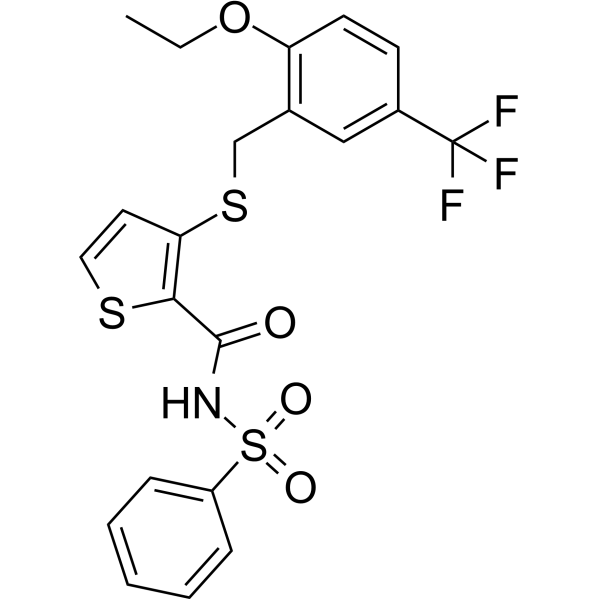
- HY-155580
-
|
|
Monoamine Oxidase
HSP
|
Cancer
|
|
MAO A/HSP90-IN-2 (compound 4-C) is a dual inhibitor of HSP90and MAO A with the IC50 values of 0.016 and 4.58 μM, respectively. MAO A/HSP90-IN-2 increases HSP70 expression and reduces HER2 and phospho-Akt expression, and decreases IFN-γ induced PD-L1 expression in GL26 cells. MAO A/HSP90-IN-2 inhibits the growth of Temozolomide (HY-17364) -sensitive and -resistant GBM cells, colon cancer, leukemia, non-small cell lung and other cancers, and has potential to inhibit tumor immune escape [1].
|
-

- HY-13260
-
|
|
Akt
Autophagy
Apoptosis
|
Cancer
|
|
CCT128930 is a ATP-competitive and selective inhibitor of AKT (IC50=6 nM for AKT2). CCT128930 has 28-fold selectivity over the closely related PKA kinase (IC50=168 nM) through the targeting of Met282 of AKT (Met173 of PKA-AKT chimera), as well as 20-fold selectivity over p70S6K (IC50=120 nM). Antitumor activity.
|
-
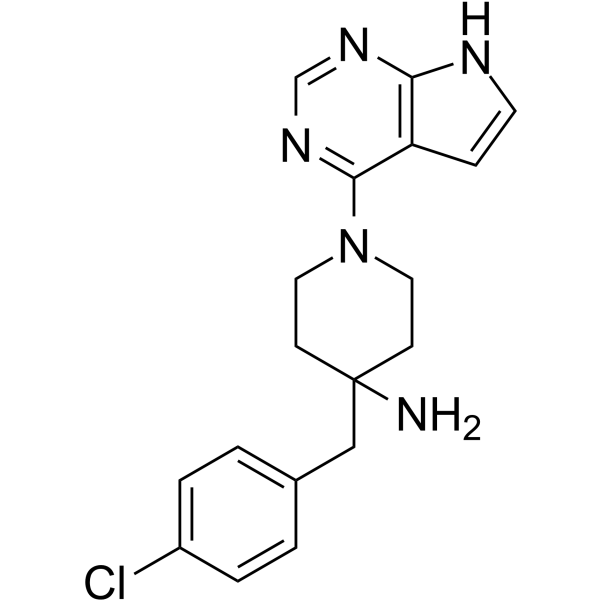
- HY-13260A
-
|
|
Akt
Autophagy
Apoptosis
|
Cancer
|
|
CCT128930 hydrochloride is a potent and selective inhibitor of AKT (IC50=6 nM). CCT128930 hydrochloride has 28-fold selectivity over the closely related PKA kinase (IC50=168 nM) through the targeting of Met282 of AKT (Met173 of PKA-AKT chimera), as well as 20-fold selectivity over p70S6K (IC50=120 nM). CCT128930 hydrochloride induces cell cycle arrest, DNA damage, and autophagy. Antitumor activity .
|
-

- HY-125269
-
TED-347
4 Publications Verification
|
YAP
|
Cancer
|
|
TED-347 is a potent, irreversible, covalent and allosteric inhibitor at YAP-TEAD protein-protein interaction with an EC50 of 5.9 μM for TEAD4⋅Yap1 protein-protein interaction. TED-347 specifically and covalently bonds with Cys-367 within the central pocket of TEAD4 with a Ki of 10.3 μM. TED-347 blocks TEAD transcriptional activity and has antitumor activity .
|
-

- HY-122575
-
|
|
P2X Receptor
Influenza Virus
Topoisomerase
MicroRNA
Apoptosis
|
Infection
Neurological Disease
Inflammation/Immunology
|
|
Aurintricarboxylic acid is a nanomolar-potency, allosteric antagonist with selectivity towards αβ-methylene-ATP-sensitive P2X1Rs and P2X3Rs, with IC50s of 8.6 nM and 72.9 nM for rP2X1R and rP2X3R, respectively . Aurintricarboxylic acid is a potent anti-influenza agent by directly inhibiting the neuraminidase . Aurintricarboxylic acid is an inhibitor of topoisomerase II and apoptosis . Aurintricarboxylic acid is a selective inhibitor of the TWEAK-Fn14 signaling pathway . Aurintricarboxylic acid also acts as a cystathionine-lyase (CSE) inhibitor with an IC50 of 0.6 μM . Aurintricarboxylic acid is a modifier of miRNAs that regulate miRNA function, with an IC50 of 0.47 µM .
|
-

- HY-146669
-
|
|
Cholinesterase (ChE)
|
Neurological Disease
|
|
BChE-IN-6 (compound 12) is a potent BChE inhibitor, with a Ki of 0.182 μM. BChE-IN-6 shows chelating capacity on Zn 2+. BChE-IN-6 can be used for Alzheimer’s disease (AD) research .
|
-
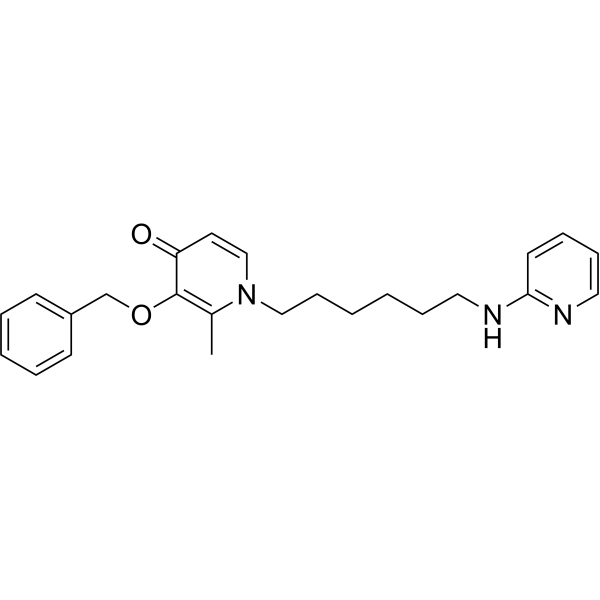
- HY-120267
-
-

| Cat. No. |
Product Name |
Type |
-
- HY-149696
-
|
|
Dyes
|
|
IR-Crizotinib is a NF-κB-inducing kinase (NIK) inhibitor that crosses the blood-brain barrier and fluorescently localizes intracranial glioblastoma (GBM) in mice (IC50=3.381 μM). IR-Crizotinib is conjugated from the near-infrared dye IR-786 and the NF-κB-inducing kinase (NIK) inhibitor Crizotinib. IR-Crizotinib can effectively inhibit the growth and invasion of glioma in vitro and in vivo and can be used in cancer research .
|
| Cat. No. |
Product Name |
Target |
Research Area |
-
- HY-P5297
-
|
|
CXCR
|
Cancer
|
|
DOTA-CXCR4-L is a CXCR4 targeting peptide. DOTA-CXCR4-L can be used in the study of cancers, including glioblastoma and triple-negative breast cancer .
|
-
- HY-P3990
-
|
|
VEGFR
Autophagy
Apoptosis
|
Cancer
|
|
Coibamide A, an N-methyl-stabilized cytotoxic depsipeptide, shows potent antiproliferative activity. Coibamide A induces autophagosome accumulation via an mTOR-independent mechanism. Coibamide A induces apoptosis. Coibamide A inhibits VEGFA/VEGFR2 expression and suppresses tumor growth in glioblastoma xenografts .
|
-
- HY-P3103
-
|
|
DNA/RNA Synthesis
|
Cancer
|
|
PINT-87aa, an 87-amino acid (aa) peptide, is encoded by the circular form of the long intergenic non-protein-coding RNA p53-induced transcript (LINC-PINT). PINT-87aa directly interacts with polymerase associated factor complex (PAF1c) and inhibits the transcriptional elongation of multiple oncogenes. PINT-87aa suppresses glioblastoma cell proliferation in vitro and in vivo .
|
-
- HY-P3103A
-
|
|
DNA/RNA Synthesis
|
Cancer
|
|
PINT-87aa TFA, an 87-amino acid (aa) peptide, is encoded by the circular form of the long intergenic non-protein-coding RNA p53-induced transcript (LINC-PINT). PINT-87aa TFA directly interacts with polymerase associated factor complex (PAF1c) and inhibits the transcriptional elongation of multiple oncogenes. PINT-87aa TFA suppresses glioblastoma cell proliferation in vitro and in vivo .
|
-
- HY-P4115
-
|
|
FABP
|
Cancer
|
|
CooP is a linear glioblastoma-targeting nonapeptide. CooP binds to the mammary-derived growth inhibitor/fatty acid binding protein 3 (FABP3) in the glioblastoma cells and its associated vasculature. CooP is used for the targeted delivery of chemotherapy and different nanoparticles .
|
-
- HY-P1828
-
|
|
Peptides
|
Cancer
|
|
EGFRvIII peptide (PEPvIII) is a tumor-specific mutation that is widely expressed in glioblastoma multiforme (GBM) and other neoplasms and its expression enhances tumorigenicity. EGFRvIII peptide represents a truly tumor-specific target for antitumor immunotherapy .
|
-
- HY-P1828A
-
|
|
Peptides
|
Cancer
|
|
EGFRvIII peptide (PEPvIII) TFA is a tumor-specific mutation that is widely expressed in glioblastoma multiforme (GBM) and other neoplasms and its expression enhances tumorigenicity. EGFRvIII peptide TFA represents a truly tumor-specific target for antitumor immunotherapy .
|
-
- HY-P2271
-
|
|
Apelin Receptor (APJ)
|
Cancer
|
|
MM 54 (compound 5) is a competitive antagonist at APJ, with an IC50 of 93 nM. MM 54 behaves as a potent and selective inhibitor of apelin binding and APLNR activation .
|
-
- HY-P3212
-
|
|
Peptides
|
Cancer
|
|
Allo-aca, a leptin peptidomimetic, is a potent, specific leptin receptor antagonist peptide. Allo-aca blocks leptin signaling and action in numerous in vitro and in vivo models .
|
-
- HY-P3212A
-
|
|
Peptides
|
Cancer
|
|
Allo-aca TFA, a leptin peptidomimetic, is a potent, specific leptin receptor antagonist peptide. Allo-aca TFA blocks leptin signaling and action in numerous in vitro and in vivo models .
|
-
- HY-16532
-
|
AEZS-108; AN-152
|
GnRH Receptor
|
Cancer
|
|
Zoptarelin doxorubicin (AEZS-108; AN-152) is a hybrid anticancer agent, containing Zoptarelin and Doxorubicin. Zoptarelin doxorubicin has been used to research targeting tumors expressing LHRH receptors. Zoptarelin doxorubicin abolishes tumor progression and induces remarkable apoptosis in vitro .
|
-
- HY-P5557
-
|
|
Bacterial
Necroptosis
|
Cancer
|
|
TP4 (Nile tilapia piscidin) is an orally active piscidin-like antimicrobial peptide. TP4 inhibits multiple gram positive and negative strains (MIC: 0.03-10 μg/mL). TP4 shows hemolytic activities. TP4 enhances immune response, antioxidant activity, and intestinal health against bacterial infections. TP4 also has anti-tumor effect, and induces necrosis by triggering mitochondrial dysfunction in cancer cells .
|
| Cat. No. |
Product Name |
Target |
Research Area |
-
- HY-P99223
-
|
MEDI-575
|
PDGFR
|
Cancer
|
|
Tovetumab (MEDI-575) is an anti-PDGFRα monoclonal antibody that selectively blocks the PDGFRα signal transduction. Tovetumab can be used in the research of glioblastoma and non-small cell lung cancer (NSCLC) .
|
-
- HY-P99806
-
|
|
Inhibitory Antibodies
|
Cancer
|
|
Pritumumab is a natural human IgG1kappa mAb originally isolated from a regional draining lymph node of a patient with cervical carcinoma. Pritumumab recognizes vimentin expressing on the cell surface of the malignant tumor. Pritumumab can be used for glioblastoma research .
|
-
- HY-P99768
-
|
TTAC-0001
|
VEGFR
|
Cancer
|
|
Olinvacimab (TTAC-0001) is a fully human anti-VEGFR2 monoclonal antibody. Olinvacimab inhibits VEGF binds to KDR with a Kd value of 0.23 nM. Olinvacimab has antiangiogenic activity. Olinvacimab can be used for the research of recurrent glioblastoma and breast cancer .
|
-
- HY-P99445
-
|
APG101; CAN008
|
TNF Receptor
|
Inflammation/Immunology
Cancer
|
|
Asunercept (APG101; CAN008) is a soluble CD95-Fc fusion protein targeting CD95L. Asunercept disrupts CD95/CD95L signaling by selectively binding to CD95L. Asunercept can be used in the research of glioblastoma multiforme (GBM), myelodysplastic syndrome (MDS), and graft-versus-host disease (GvHD) .
|
-
- HY-P99908
-
|
NT-17
|
Interleukin Related
|
Cancer
|
|
Efineptakin alfa (NT-17) is a long-acting recombinant human IL-7. Efineptakin alfa supports the proliferation and survival CD4 + and CD8 + cells in both human and mice. Efineptakin alfa can be used for glioblastoma research .
|
| Cat. No. |
Product Name |
Category |
Target |
Chemical Structure |
| Cat. No. |
Compare |
Product Name |
Species |
Source |
Compare Products
|
| Products |
|
| Cat. No. |
|
| Species |
|
| Source |
|
| Tag |
|
| Accession |
|
| Gene ID |
|
| Molecular Weight |
|
| Purity |
|
| Endotoxin Level |
|
| Biological Activity |
|
| Appearance |
|
| Formulation |
|
| Storage & Stability |
|
| Shipping |
|
| Free Sample |
Yes
No
|
| Size |
* This product has been "discontinued".
Optimized version of product available:
|
| Cat. No. |
Product Name |
Chemical Structure |
| Cat. No. |
Product Name |
|
Classification |
-
- HY-153627
-
|
|
|
Alkynes
|
|
G13KS is a deubiquitinase UCHL1 ligand and inhibitor. G13KS inhibits recombinant and cellular UCHL1. G13KS reduces levels of monoubiquitin in human glioblastoma cells . GK13S is a click chemistry reagent, it contains an Alkyne group and can undergo copper-catalyzed azide-alkyne cycloaddition (CuAAc) with molecules containing Azide groups.
|
Your information is safe with us. * Required Fields.
Inquiry Information
- Product Name:
- Cat. No.:
- Quantity:
- MCE Japan Authorized Agent:


































































































































































